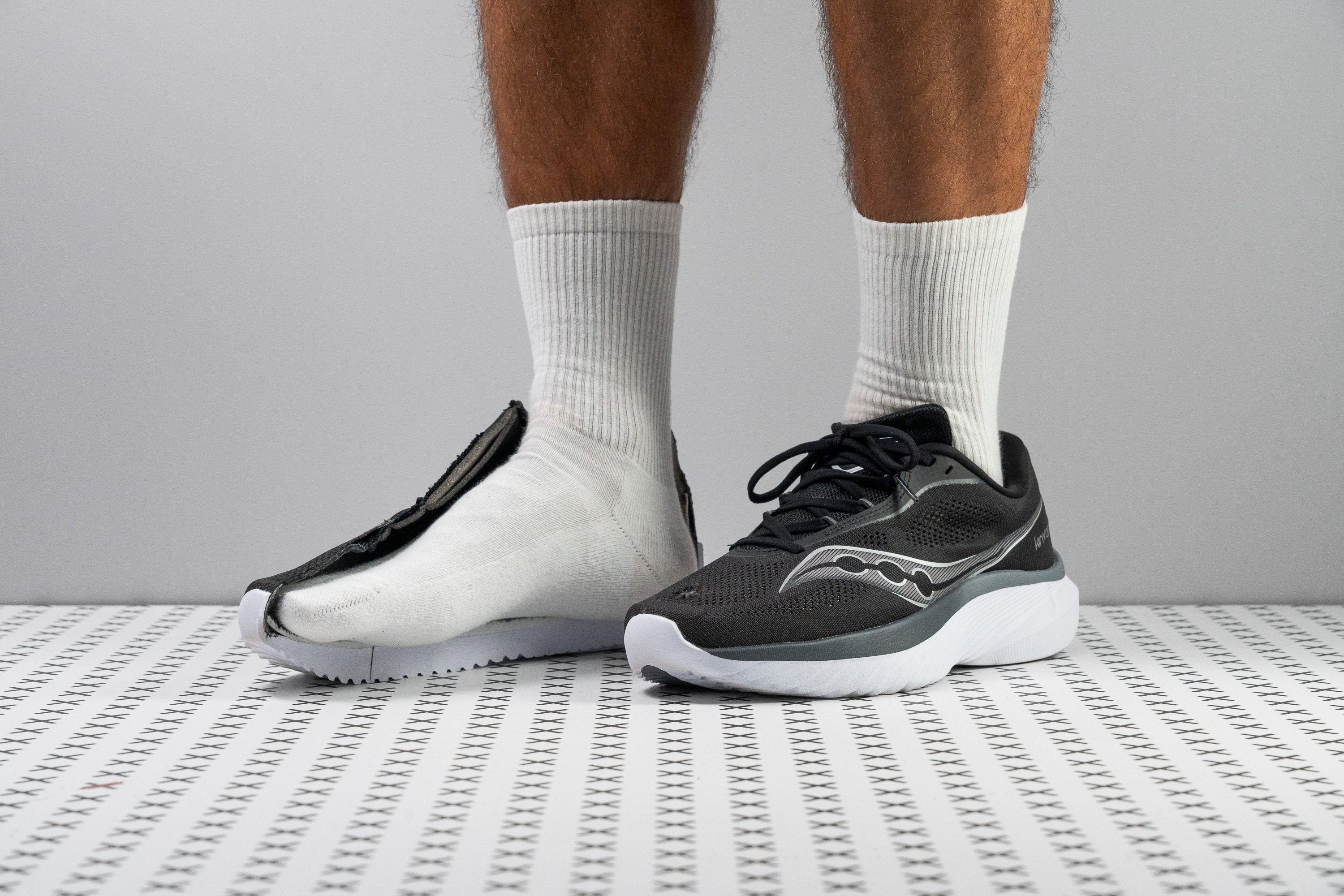Our verdict
- Top pick in best treadmill running shoes
- Top pick in best Saucony running shoes
Pros
- Easy on the wallet
- Feels great at faster paces
- Really fun
- Retains classic Kinvara vibes
- Stable, low-to-the-ground ride
- Suitable for daily wear
- Exceptionally lightweight
- Enhances foot strength
- Top-notch breathability
Cons
- Limited to short runs
- Not ideal for heel strikers
- Toebox durability
- Minimal outsole rubber coverage
Audience verdict
Comparison
The most similar running shoes compared
+ + Add a shoe | |||||
|---|---|---|---|---|---|
| Audience score | 84 Good! | 87 Great! | 87 Great! | 87 Great! | |
| Price | £130 | £125 | £110 | £130 | |
| Pace | Daily runningTempo | CompetitionTempo | Daily running | Daily running | |
| Shock absorption | Moderate | - | - | Moderate | |
| Energy return | Moderate | - | - | Low | |
| Traction | Moderate | - | - | Moderate | |
| Arch support | Neutral | Neutral | Neutral | Neutral | |
| Weight lab Weight brand | 6.8 oz / 194g 6.7 oz / 190g | 7.9 oz / 224g 7.9 oz / 224g | 9 oz / 254g 9.4 oz / 266g | 8.2 oz / 232g 8.5 oz / 241g | |
| Lightweight | ✓ | ✓ | ✗ | ✓ | |
| Drop lab Drop brand | 4.4 mm 4.0 mm | 1.1 mm 0.0 mm | 6.0 mm 8.0 mm | 6.4 mm 6.0 mm | |
| Strike pattern | Mid/forefoot | Mid/forefoot | Mid/forefoot | Mid/forefoot | |
| Size | Slightly small | True to size | True to size | True to size | |
| Midsole softness | Balanced | Balanced | Balanced | Balanced | |
| Difference in midsole softness in cold | Small | Normal | Small | Big | |
| Toebox durability | Bad | Good | Bad | Good | |
| Heel padding durability | Good | Decent | Decent | Decent | |
| Outsole durability | Good | Good | Good | - | |
| Breathability | Breathable | Breathable | Warm | Moderate | |
| Width / fit | Medium | Wide | Medium | Narrow | |
| Toebox width | Medium | Wide | Medium | Narrow | |
| Stiffness | Flexible | Moderate | Stiff | Moderate | |
| Torsional rigidity | Flexible | Flexible | Flexible | Moderate | |
| Heel counter stiffness | Flexible | Flexible | Flexible | Flexible | |
| Heel lab Heel brand | 27.9 mm 30.0 mm | 22.5 mm 24.0 mm | 30.2 mm 27.0 mm | 30.4 mm 26.0 mm | |
| Forefoot lab Forefoot brand | 23.5 mm 26.0 mm | 21.4 mm 24.0 mm | 24.2 mm 19.0 mm | 24.0 mm 20.0 mm | |
| Widths available | NormalWide | Normal | Normal | NormalWide | |
| Orthotic friendly | ✓ | ✓ | ✓ | ✓ | |
| Season | SummerAll seasons | SummerAll seasons | All seasons | All seasons | |
| Removable insole | ✓ | ✓ | ✓ | ✓ | |
| Ranking | #240 Bottom 35% | #151 Top 41% | #164 Top 45% | #156 Top 43% | |
| Popularity | #178 Top 48% | #248 Bottom 33% | #309 Bottom 16% | #89 Top 24% |
Who should buy
The Kinvara 15 stands out as a refreshing alternative in a world dominated by maximalist designs. Here in the lab, we believe it's:
- An excellent choice for those exploring low-drop, low-stack running shoes for the first time.
- Perfect for fans of the Kinvara series, offering the familiar feel with subtle enhancements throughout.
- An ideal option for runners looking to strengthen their feet without committing to full zero-drop or ultra-minimalist shoes, all at an attractive price.
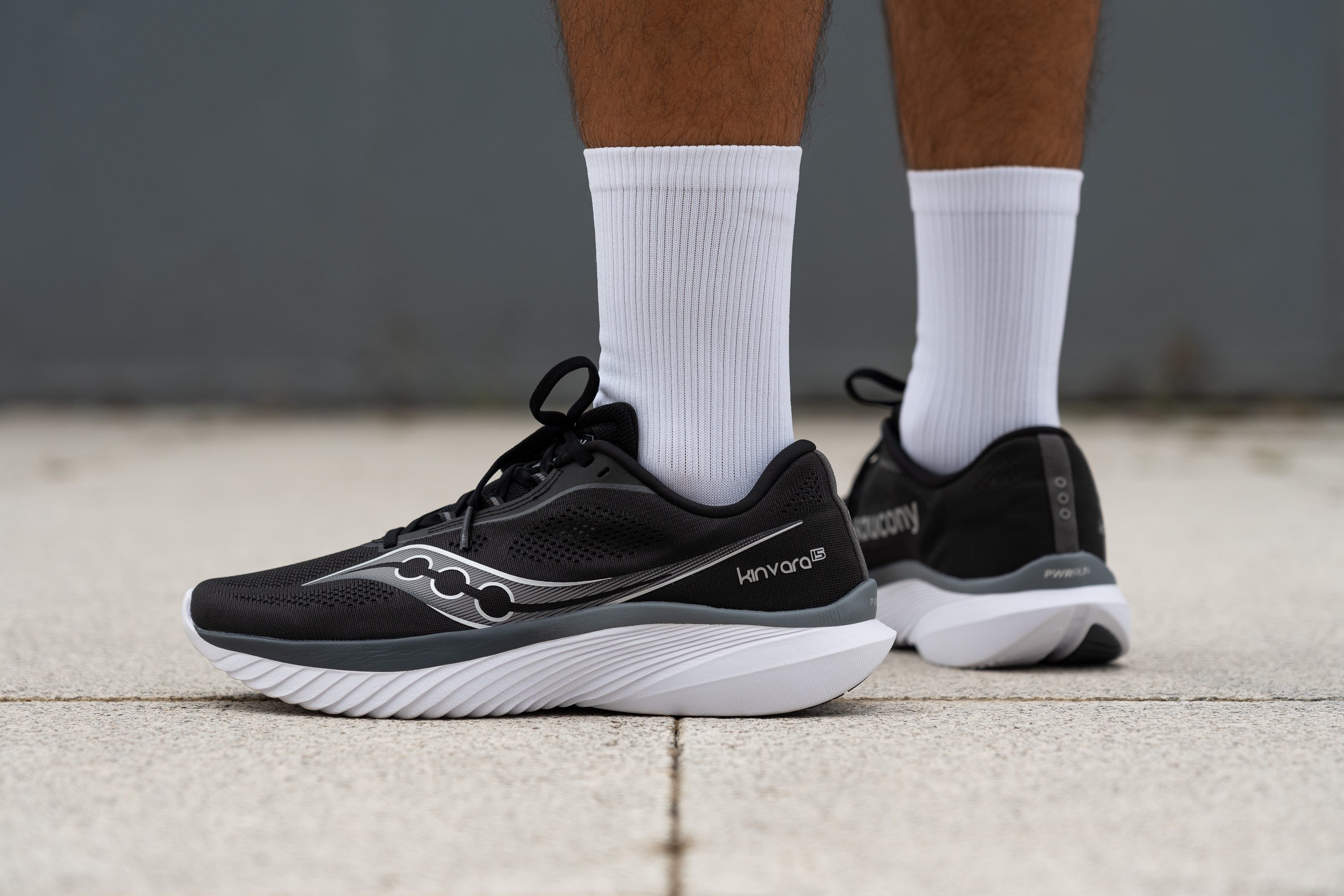
Who should NOT buy
While the Kinvara 15 rocks an impressive lightweight design, we do not recommend it if outsole durability is crucial for you. The minimal rubber coverage leads to faster wear, especially for overpronators or those who run in gravel roads. For a similar lightweight build but with enhanced rubber coverage, we suggest checking out the Nike Streakfly or the Adidas Adios 8.
Additionally, we think the Kinvara 15 falls short in terms of energy return. Runners seeking a more responsive ride might prefer the previously mentioned alternatives. Also, the ultra-lightweight Saucony Sinister offers a similar low-stack design but includes the superior PWRRUN PB foam for better performance.
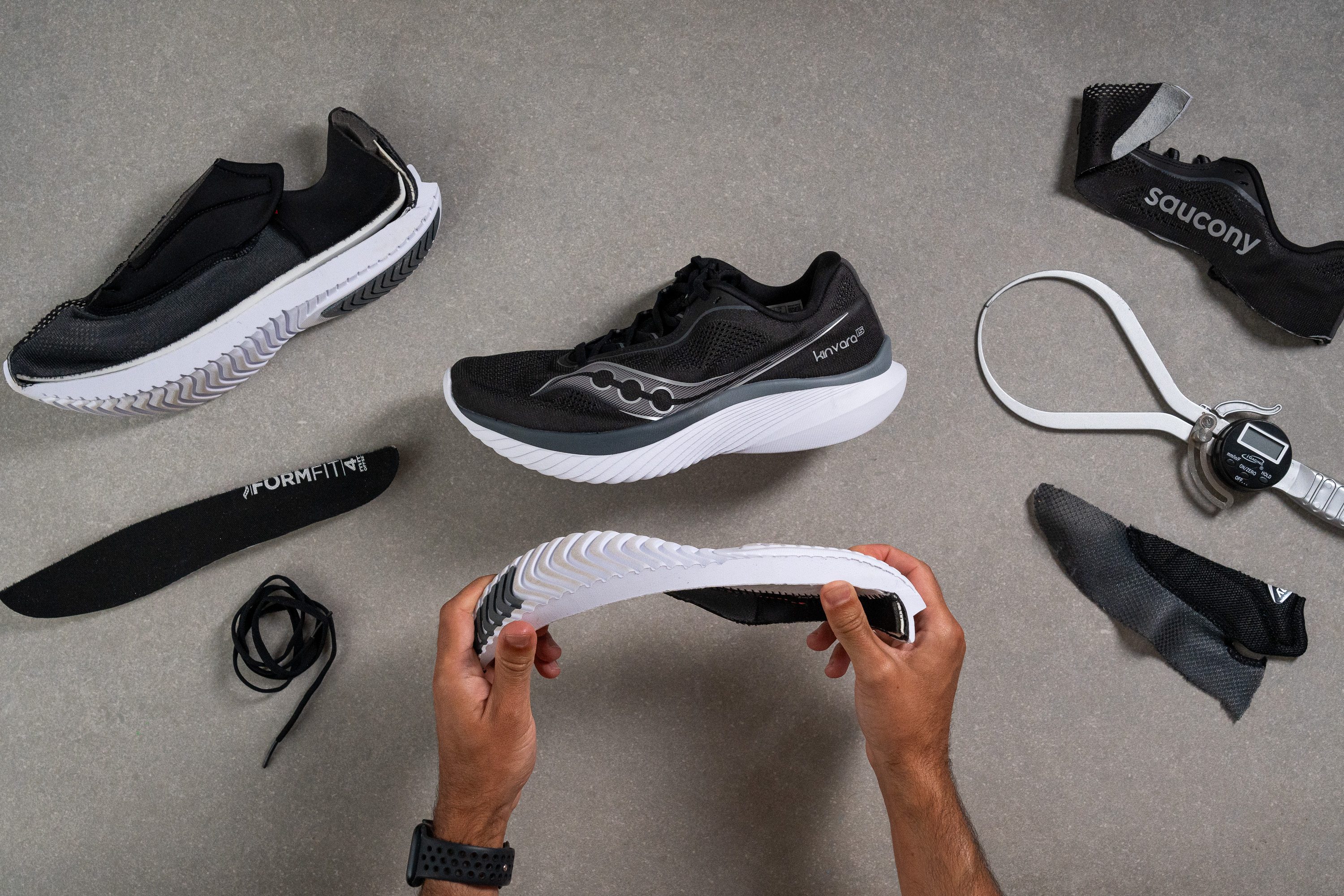
Cushioning
Shock absorption
Some runners felt the previous Kinvara lacked the sharp ground feel of earlier versions. That’s likely why Saucony dialed back cushioning in this update, now measuring 117 SA in the heel and 107 SA in the forefoot.
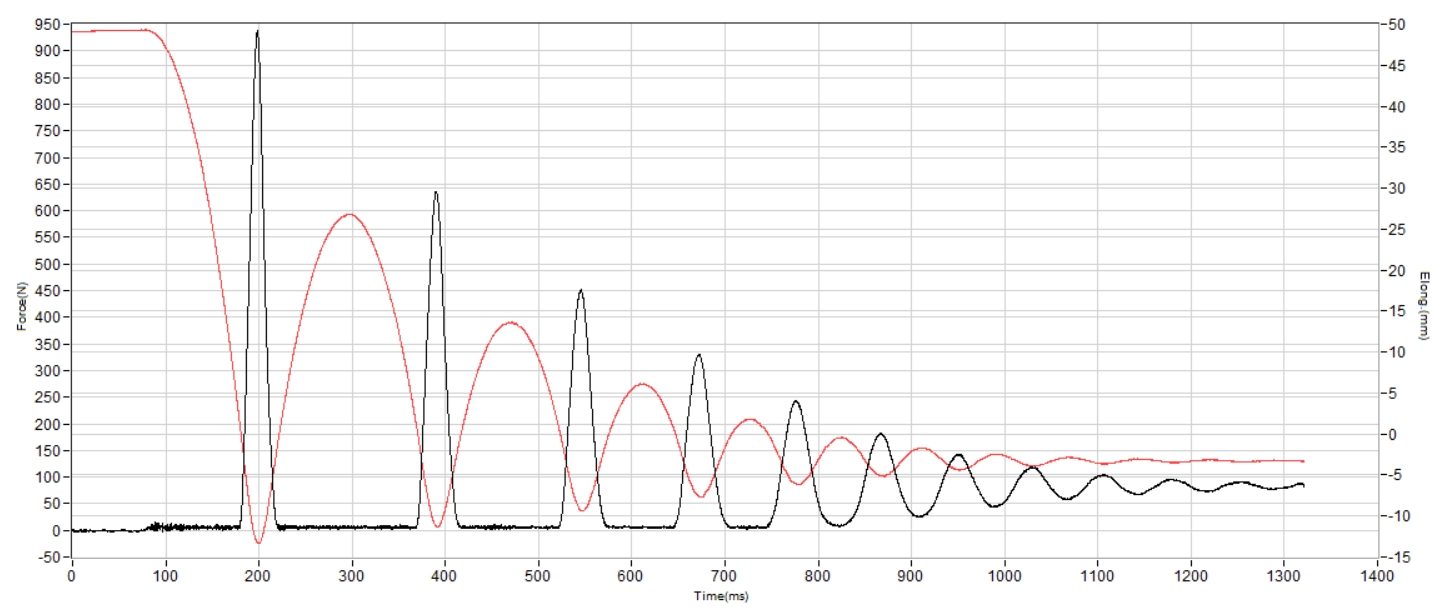
| Kinvara 15 | 117 SA |
| Average | 129 SA |
Energy return
The midsole stays mostly the same and delivers moderate bounce with 57.2% in the heel and 60.8% in the forefoot. Given the Kinvara’s price range, we doubt it’ll offer much more in the near future.
| Kinvara 15 | 57.2% |
| Average | 58.5% |
Heel stack
Saucony advertises the Kinvara with a 30/26 mm stack height, but our lab measurements revealed slightly less cushioning.
The heel measured at 27.9 mm—2.1 mm less than expected. However, this could actually be beneficial for runners seeking a ride with more ground feel. As they say, it's always good to look on the bright side of life!
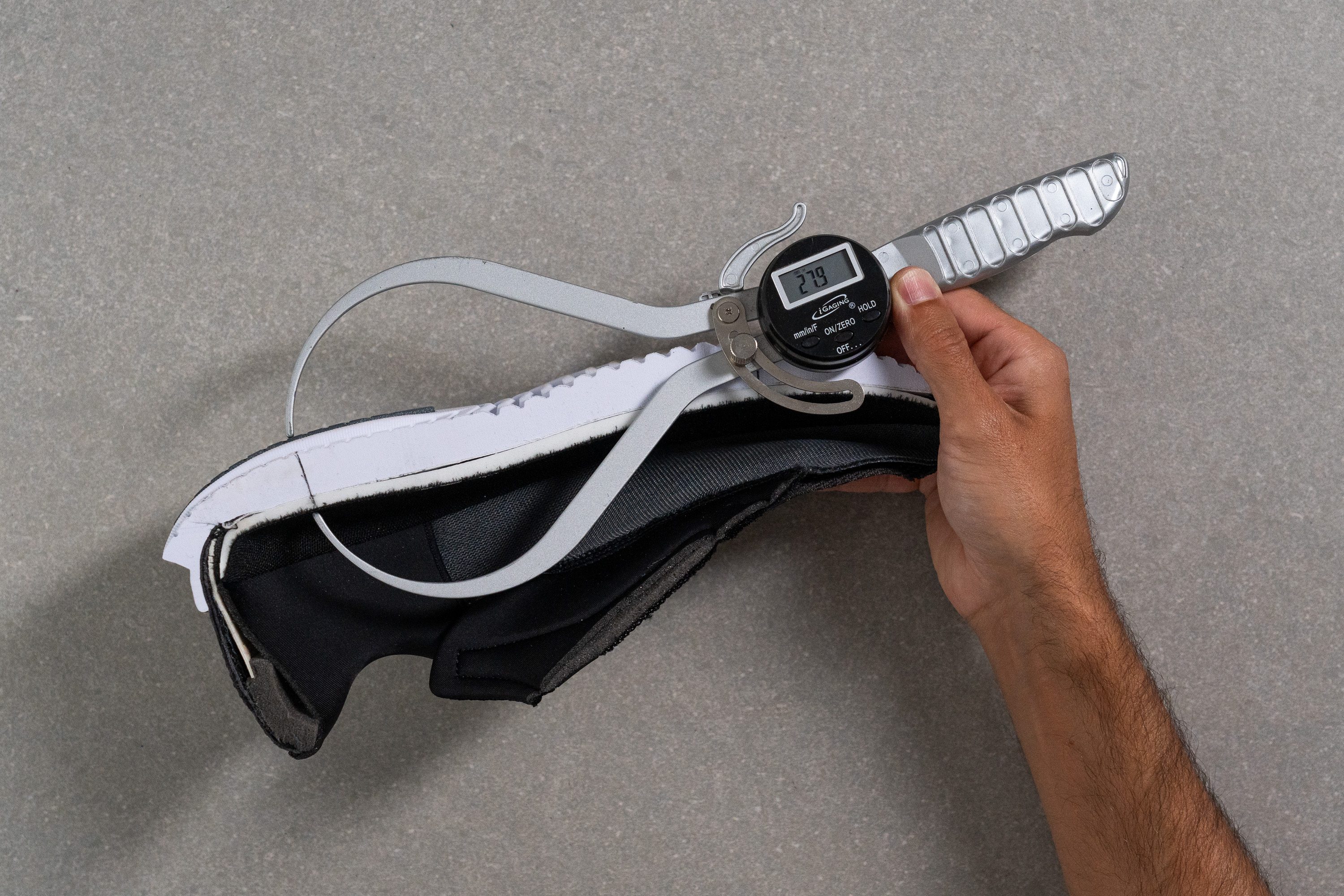
| Kinvara 15 | 27.9 mm |
| Average | 34.8 mm |
Forefoot stack
Consequently, the forefoot also measures lower than the claimed 26 mm, coming in at just 23.5 mm. While this is a slight deviation from the specified specs, it’s hardly noticeable and unlikely to affect most runners. We'd be surprised if anyone could detect such a subtle difference in cushioning.
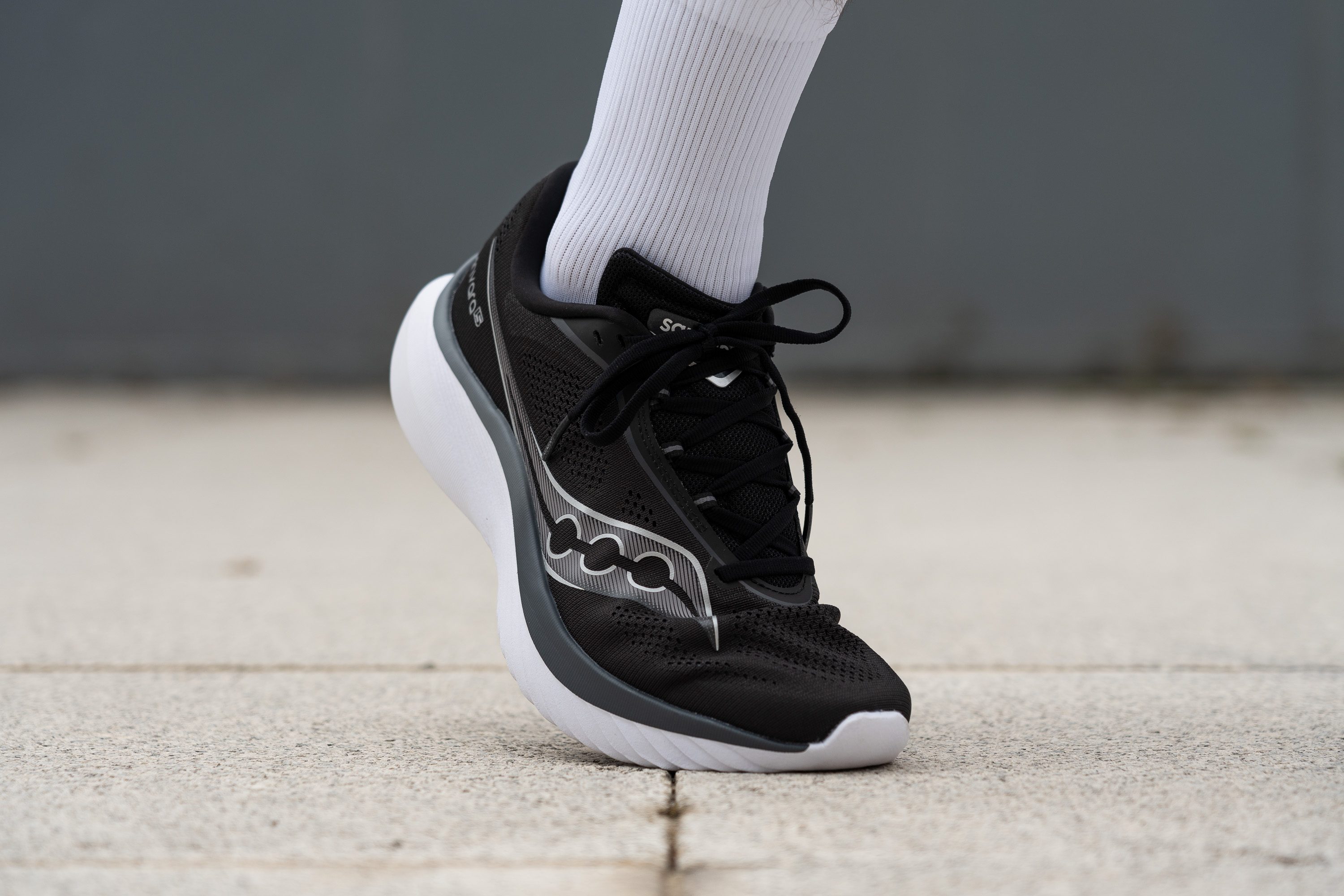
This measurement further supports a well-known fact among Kinvara lovers—this shoe isn't designed for long-distance runs or heavier runners, which comes with both advantages and disadvantages.

| Kinvara 15 | 23.5 mm |
| Average | 26.2 mm |
Drop
Another signature trait of the Kinvara DNA is its low-drop design, which we verified in the lab. We measured a drop of 4.4 mm, aligning closely with the brand’s claim of 4 mm.
This drop is ideal for midfoot and forefoot strikers, who can fully benefit from this design. On the flip side, while heel strikers could use the Kinvara, it’s not the best fit for them due to the low offset and the shoe's flat, non-rockered profile. We suggest the Nike Free RN NN instead.
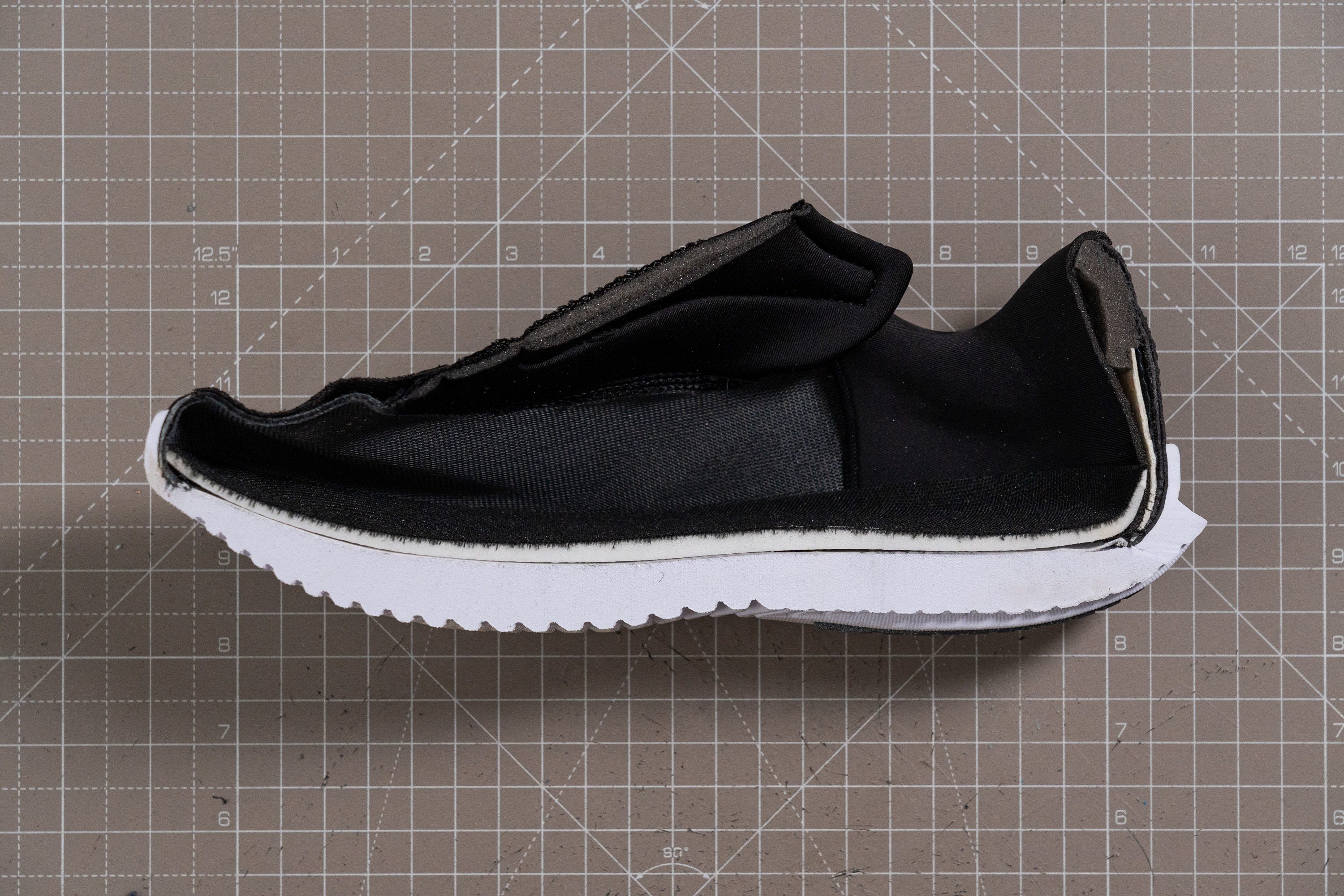
| Kinvara 15 | 4.4 mm |
| Average | 8.6 mm |
Midsole softness
Now, let's talk about the PWRRUN midsole. Yes, Saucony continues to bypass their Pebax-based, bouncier PWRRUN PB foam for the Kinvara series, and understandably so—it's hard to maintain the current price range of the Kinvara with such a premium material.
So why choose PWRRUN over PWRRUN+? The answer lies in the weight. PWRRUN+ is certainly more responsive, but it's significantly heavier because it is fully made from TPU. On the other side, PWRRUN is a mix of EVA and TPU, which makes it lighter.
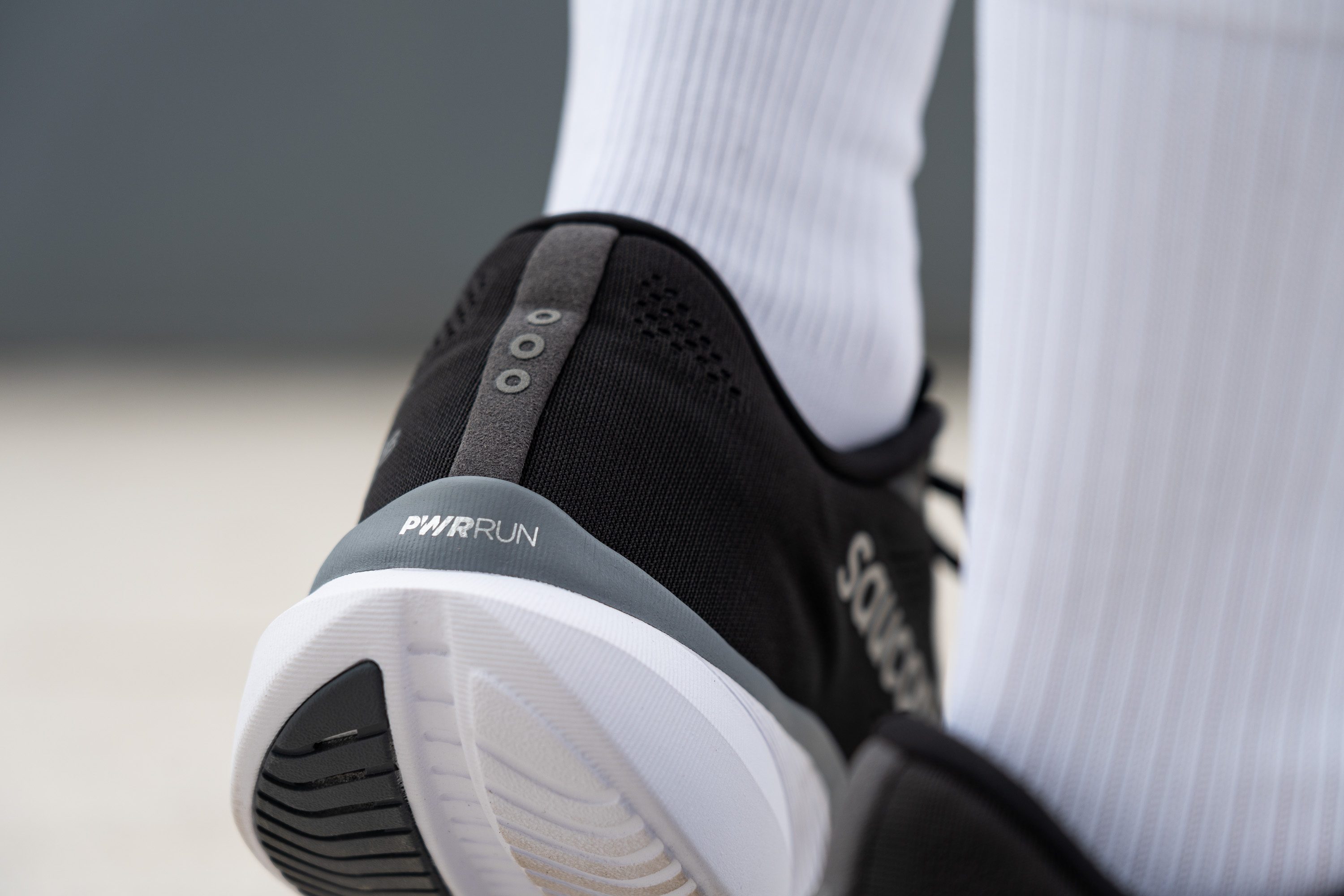
Measuring at 23.8 HA on our durometer, we discovered that the ride is on the firmer side, which is likely a wise decision for such a thin midsole to avoid the risk of bottoming out at every stride.
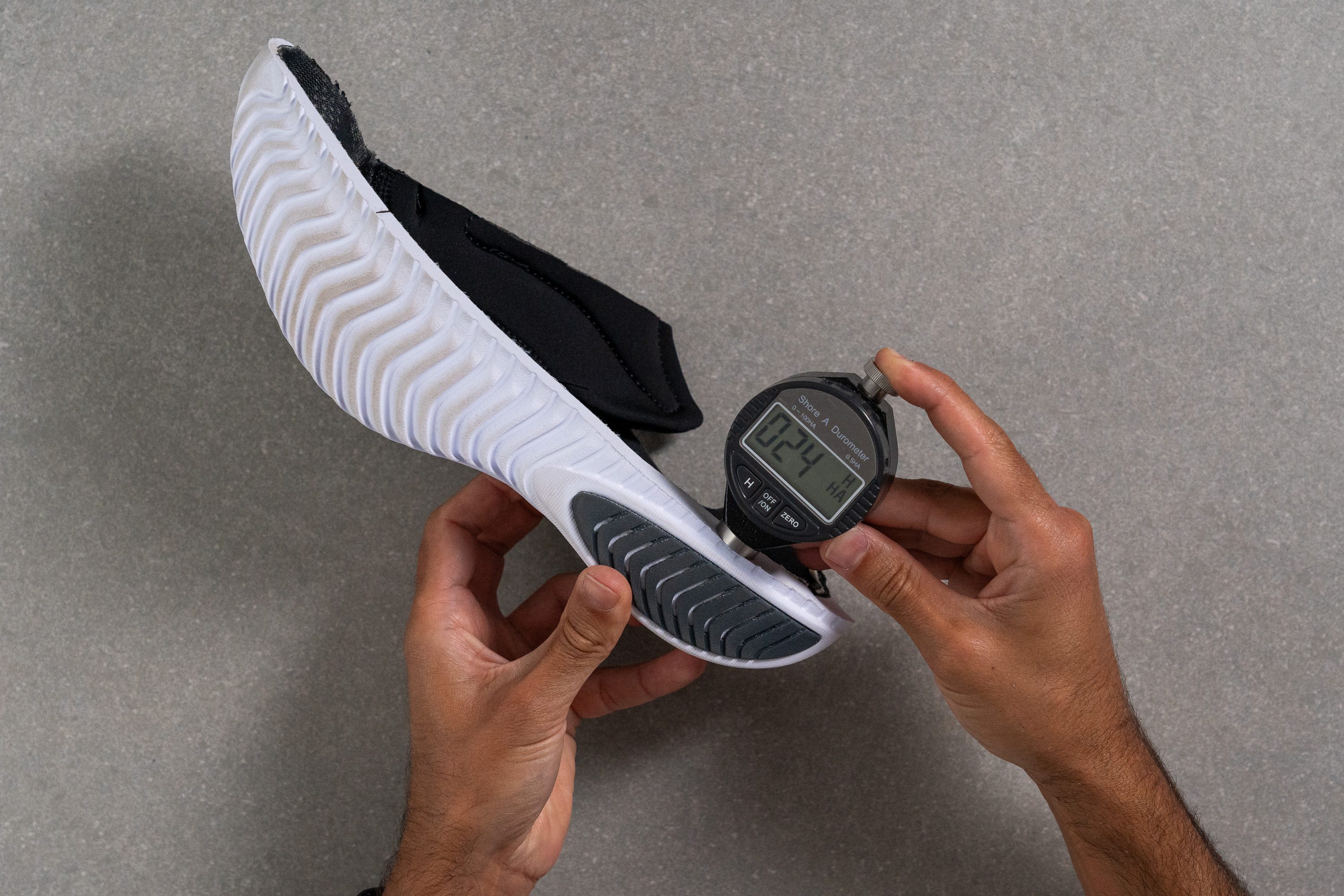
| Kinvara 15 | 23.8 HA |
| Average | 20.4 HA |
Rocker
While many models are adopting a rockered silhouette—some to extreme degrees—Saucony has chosen to keep the Kinvara true to its origins. This means maintaining a flat, non-rockered midsole that we absolutely adore.
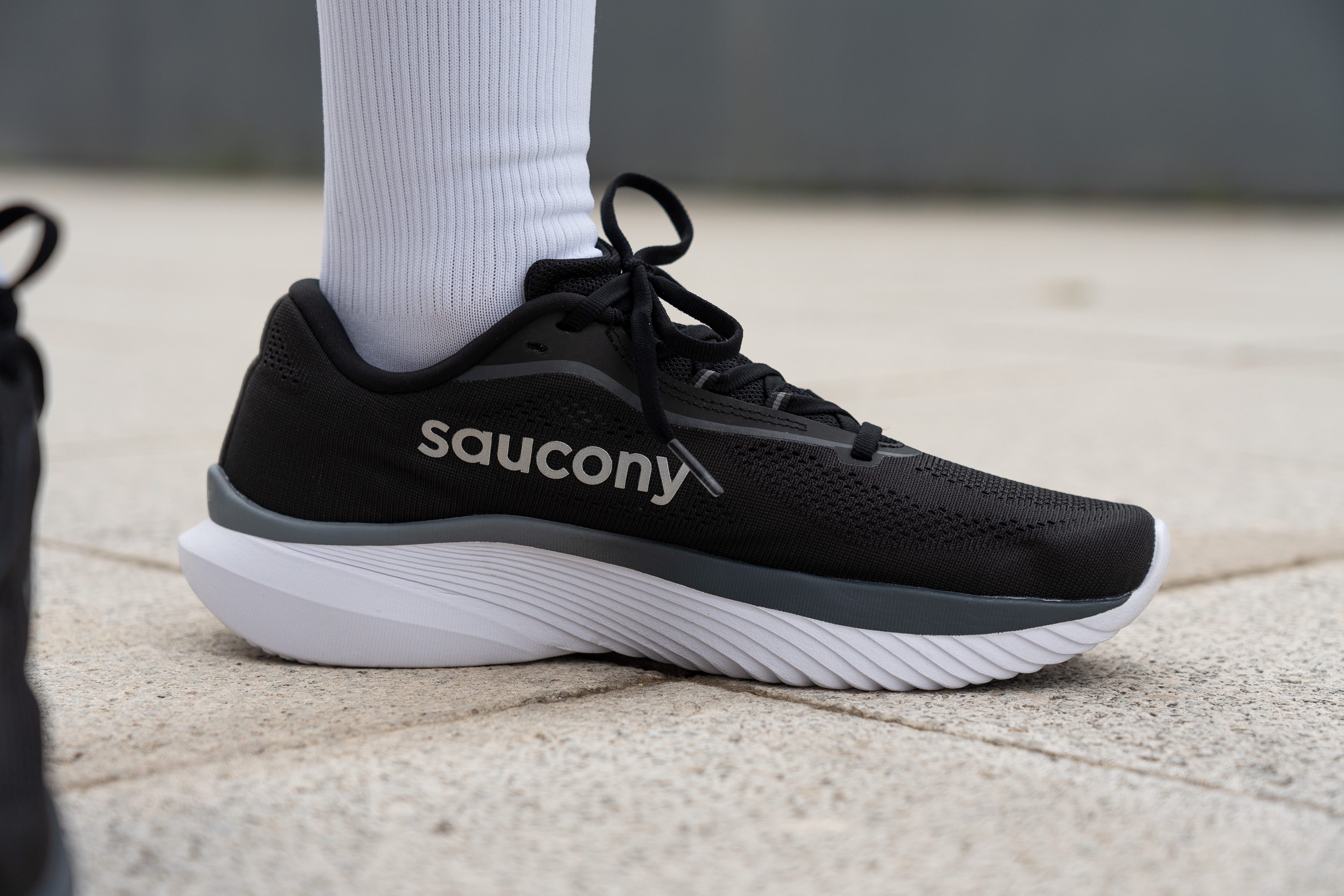
With the midsole staying under 30 mm in both the forefoot and heel and no plate to restrict flexibility, there's no need for a pronounced toe spring. As a result, the Kinvara offers a natural ride that we've found to be excellent for promoting foot strength, making it an interesting choice in today's market.

Size and fit
Size
Saucony Kinvara 15 fits slightly small (47 votes).
Width / Fit
We measured the Kinvara 15 to be exactly 96.2 mm at its widest point, just around the average.
And that's precisely how the shoe feels—perfectly average. We tested it on both short and medium distances, consistently experiencing a secure and well-supported fit.
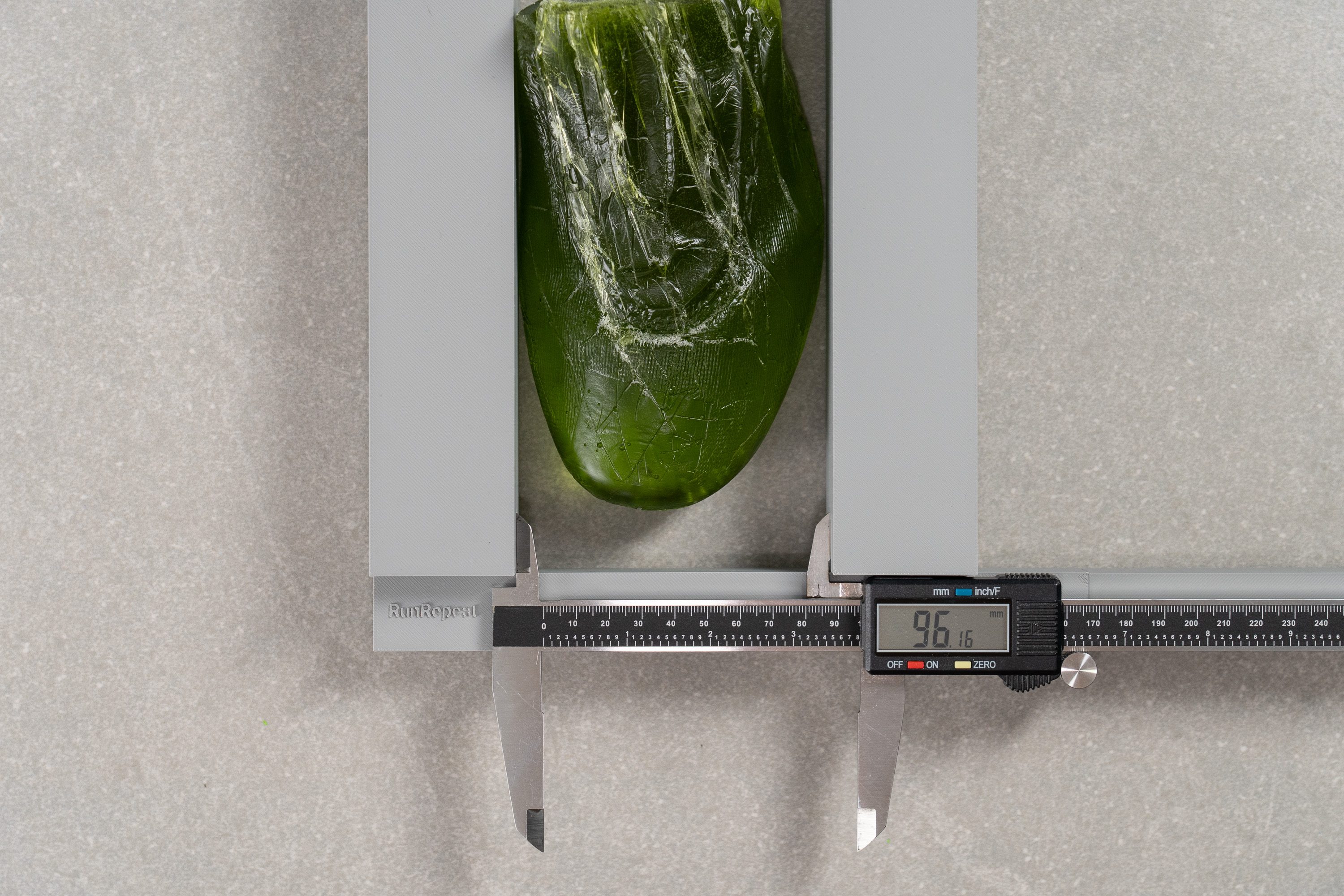
| Kinvara 15 | 96.2 mm |
| Average | 95.1 mm |
Toebox width
With a width of 71.2 mm in the big toe area, we suggest tempering expectations for ample toe wiggle room, because it's not gonna happen.

In fact, if a spacious toebox paired with a minimalist, low-drop design is what you aim for, we recommend the Altra Escalante Racer 2.

| Kinvara 15 | 71.2 mm |
| Average | 73.3 mm |
Toebox height
We measured an impressive 31.4 mm in height, surpassing the vertical space provided by most running shoes.
However, this extra-generous design—while ideal for those seeking comfort—may not satisfy runners who prefer a snugger, precision-oriented fit for running at faster paces.
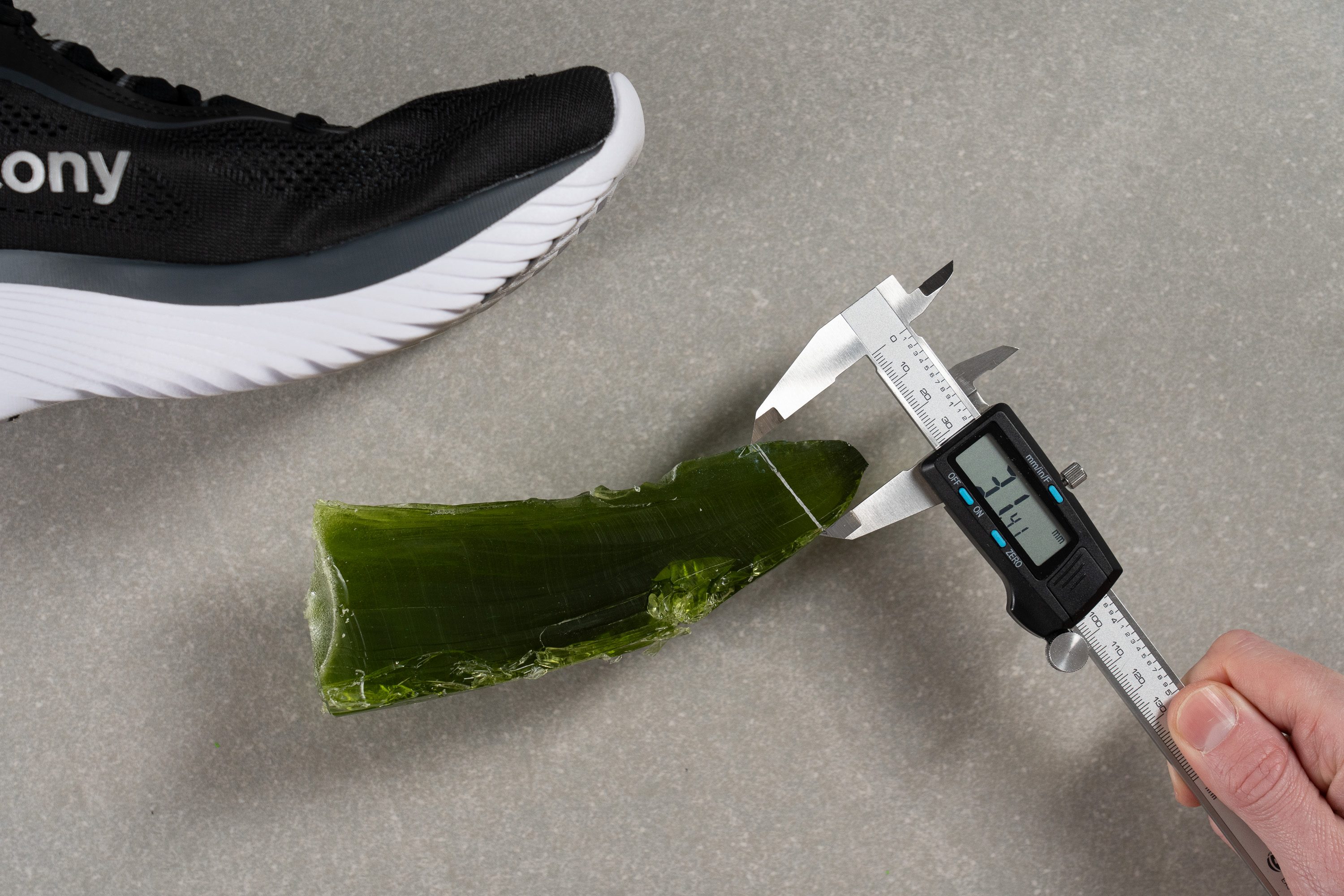
| Kinvara 15 | 31.4 mm |
| Average | 27.1 mm |
Traction / Grip
Traction test
We measured a 0.41 score for the Saucony Kinvara 15—solid performance across all weather conditions. That’s quite impressive given how much exposed foam this outsole features compared to other lightweight trainers.
| Kinvara 15 | 0.41 |
| Average | 0.48 |
Outsole design
Saucony’s focus on weight-saving design is clear in this outsole, where exposed foam dominates nearly the entire surface. Aside from two modest rubber pods—one at the lateral heel and another at the medial forefoot—the outsole relies on a reinforced EVA.
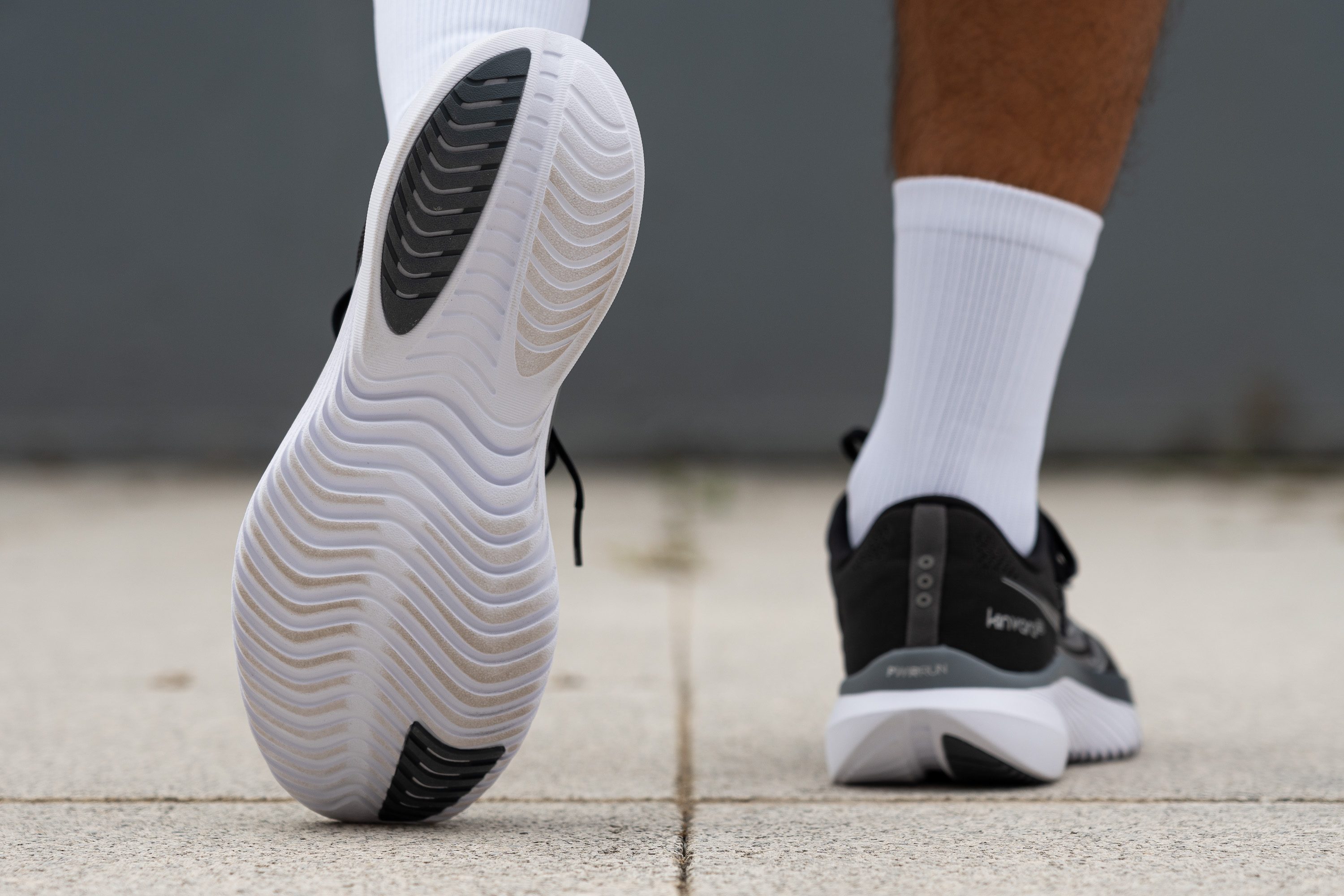
Flexibility / Stiffness
The Kinvara 15 lacks a plate, features a low stack height, and has an outsole that's mostly devoid of rubber but includes numerous grooves. Essentially, this shoe is engineered for exceptional longitudinal flexibility, and we were ready to confirm this in our lab.
To do so, we secured the shoe to a table and flexed it up to 30 degrees using our machine. The process required minimal effort on our part, only needing 9.1N to achieve this bend. This demonstration not only highlights its superb flexibility but also indicates great comfort for everyday wear.
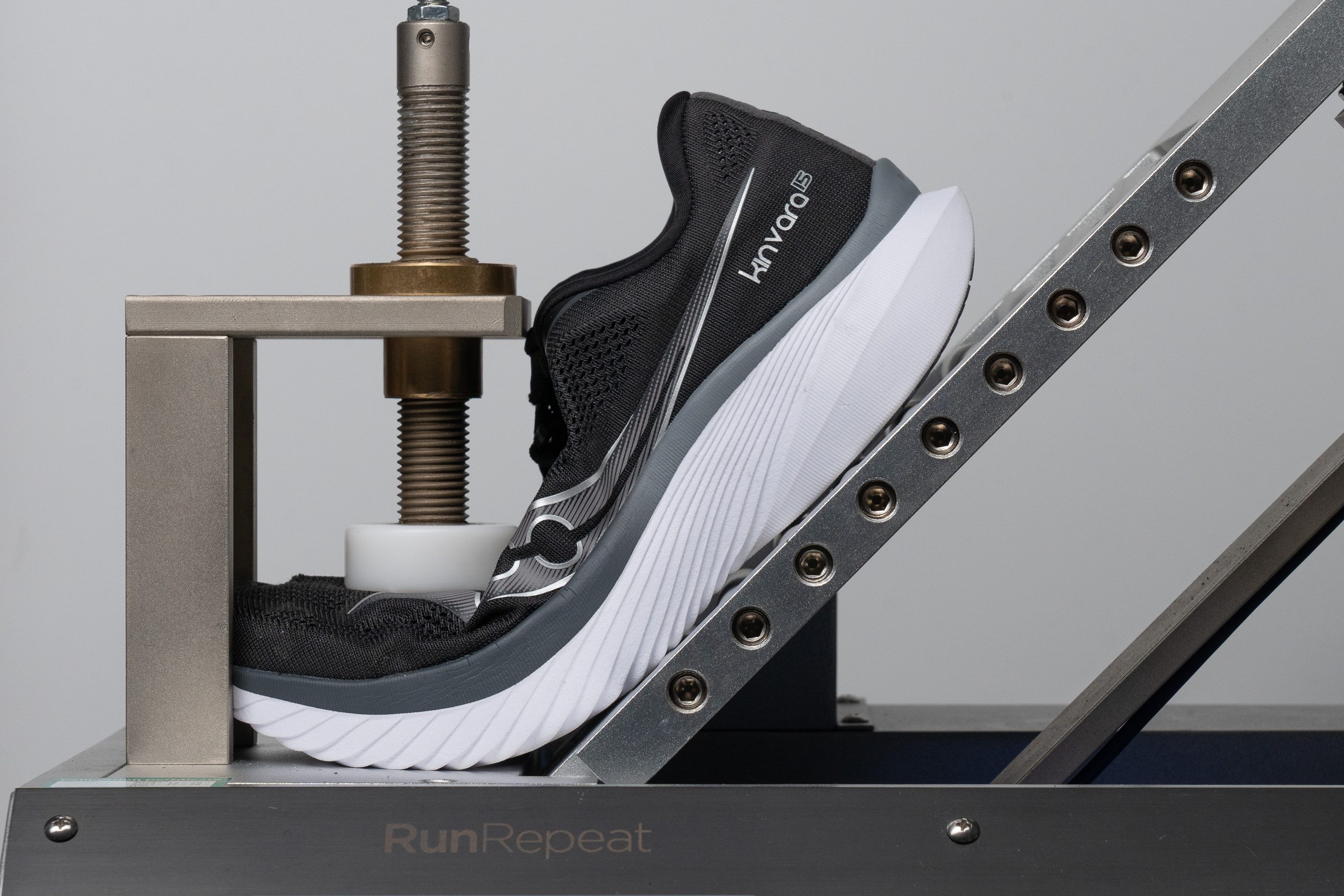
| Kinvara 15 | 9.1N |
| Average | 15.3N |
Stiffness in cold (%)
Upon repeating our freezer test, we encountered a less-than-ideal outcome. This time, the stiffness increased by 39.3%, a change that would undoubtedly be noticeable and detrimental under cold temperatures.
| Kinvara 15 | 39% |
| Average | 33% |
Weight
If we had to sum up the Kinvara 15 in one word, it would undoubtedly be "lightweight." This was our immediate impression upon unboxing and holding the shoe, and it was further confirmed during our initial test runs. We then verified its weight on our scale, eager to see if it lived up to expectations.
True to its heritage, the Kinvara 15 clocked in at an impressively light 6.85 oz or 194g—mirroring the weight of its predecessor. So yes, the Kinvara DNA is still very much intact!
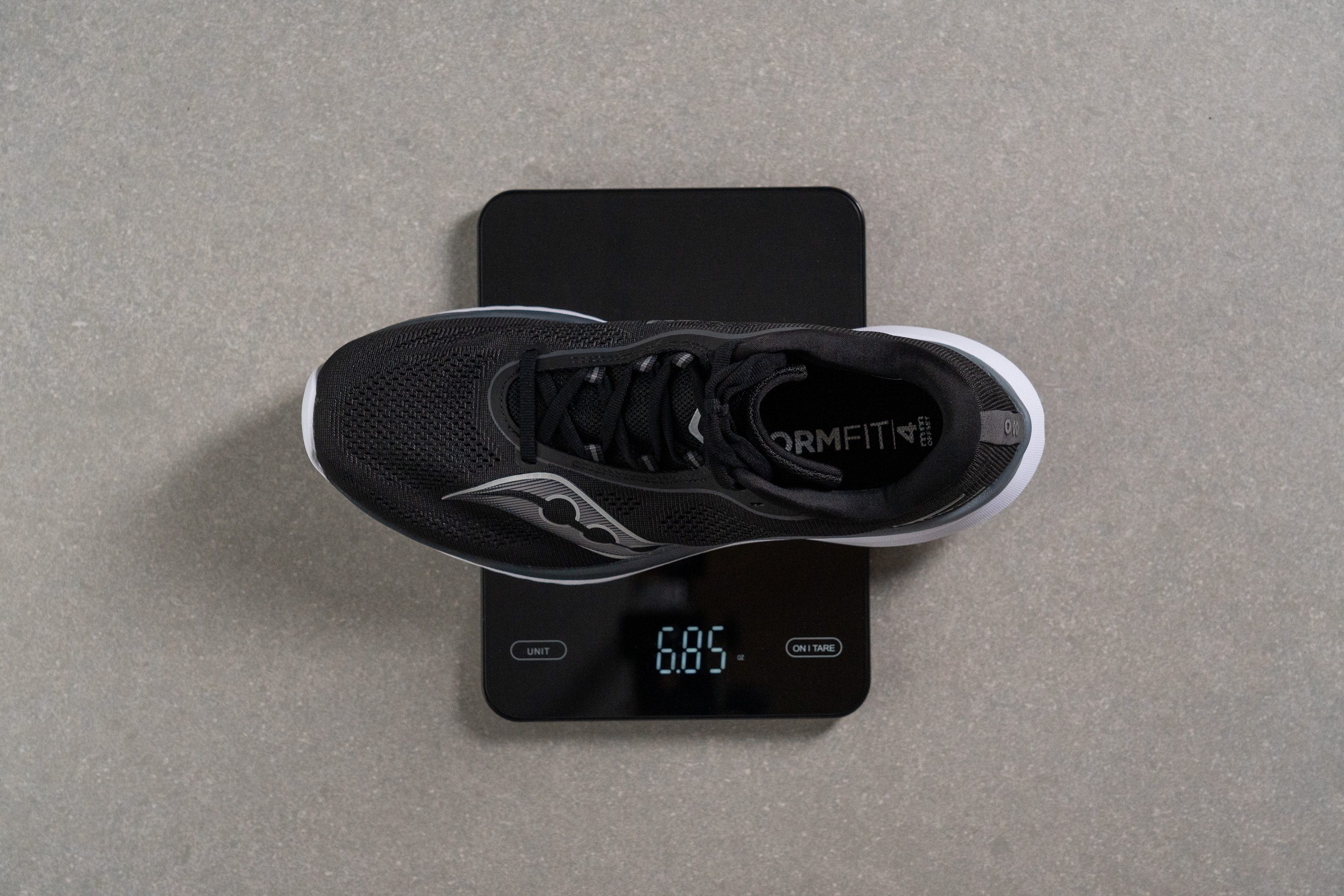
| Kinvara 15 | 6.8 oz (194g) |
| Average | 9.3 oz (264g) |
Breathability
Just after unboxing the Kinvara 15, we noticed the engineered mesh upper was full of tiny holes throughout the toebox and midfoot, suggesting excellent breathability. To verify this, we put our smoke machine into action and observed the smoke streaming out of the Kinvara 15 effortlessly—earning it a perfect score of 5 out of 5 in our first test of the day.
We shone a light to reveal all those tiny holes and were pleased to discover an abundance of them not only in the toebox—where nearly every shoe boasts good ventilation—but also along the sides, indicating that the Kinvara goes beyond the average.
We also examined the engineered mesh under our microscope to get as close a look as possible. As expected, we found nothing particularly noteworthy here; it's a straightforward and cost-effective mesh upper that performs awesome in warm weather though.
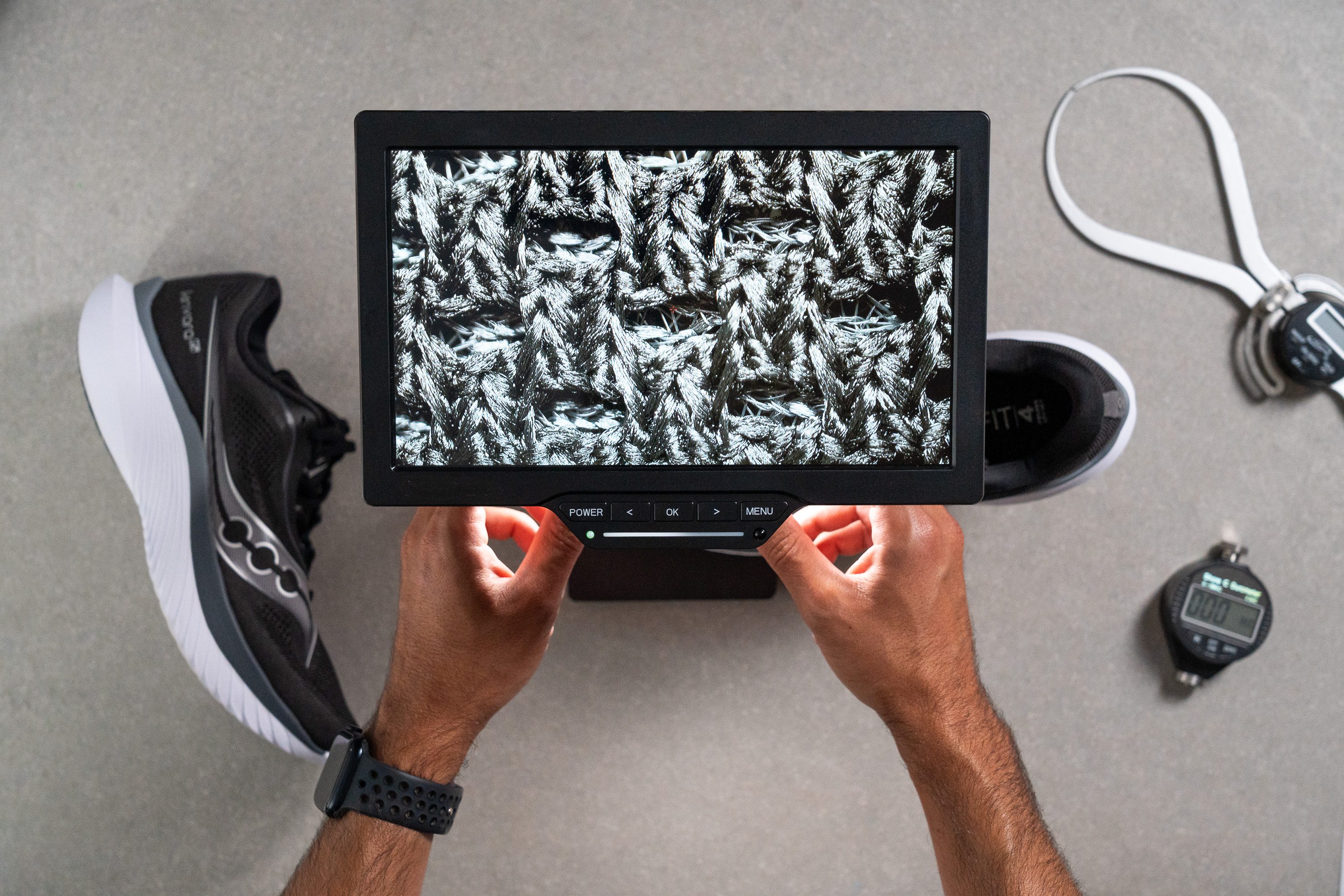
Saucony has opted for a rare mesh setup with a thinner layer on the outside and a plush fabric on the inside—a reversal of the more common design.
The padding is substantial, despite the shoe's light weight, and there's a noticeable interior heel counter made of a white cardboard material.
| Kinvara 15 | 5 |
| Average | 3.7 |
Stability
Lateral stability test
The Kinvara 15 might not seem particularly stable at first glance, but it could indeed surprise many with its performance.
It features a moderately firm midsole, a low stack height, and some midsole sidewalls, making it suitable for runners with minor stability needs, especially those who are midfoot or forefoot strikers.
Torsional rigidity
The Kinvara leans towards minimalism, so we anticipated easy flexibility during our lab tests. Indeed, we rated its flexibility at 2 out of 5. As shown in the video, it's really flexible, yet a tiny bit stiffer than the previous version.
| Kinvara 15 | 2 |
| Average | 3.5 |
Heel counter stiffness
The heel counter of the Kinvara 15 includes an internal cardboard piece for structure but sits quite low and not very rigid. Consistent with our previous assessment, we gave it a 2 out of 5 in this test. This rating fits well with the Kinvara DNA—it's more flexible than the average running shoe, yet it doesn't reach the highest levels.
| Kinvara 15 | 2 |
| Average | 2.9 |
Midsole width - forefoot
We discovered a slight 1.7 mm increase in width for the Kinvara 15 compared to its predecessor, a change that is virtually negligible.
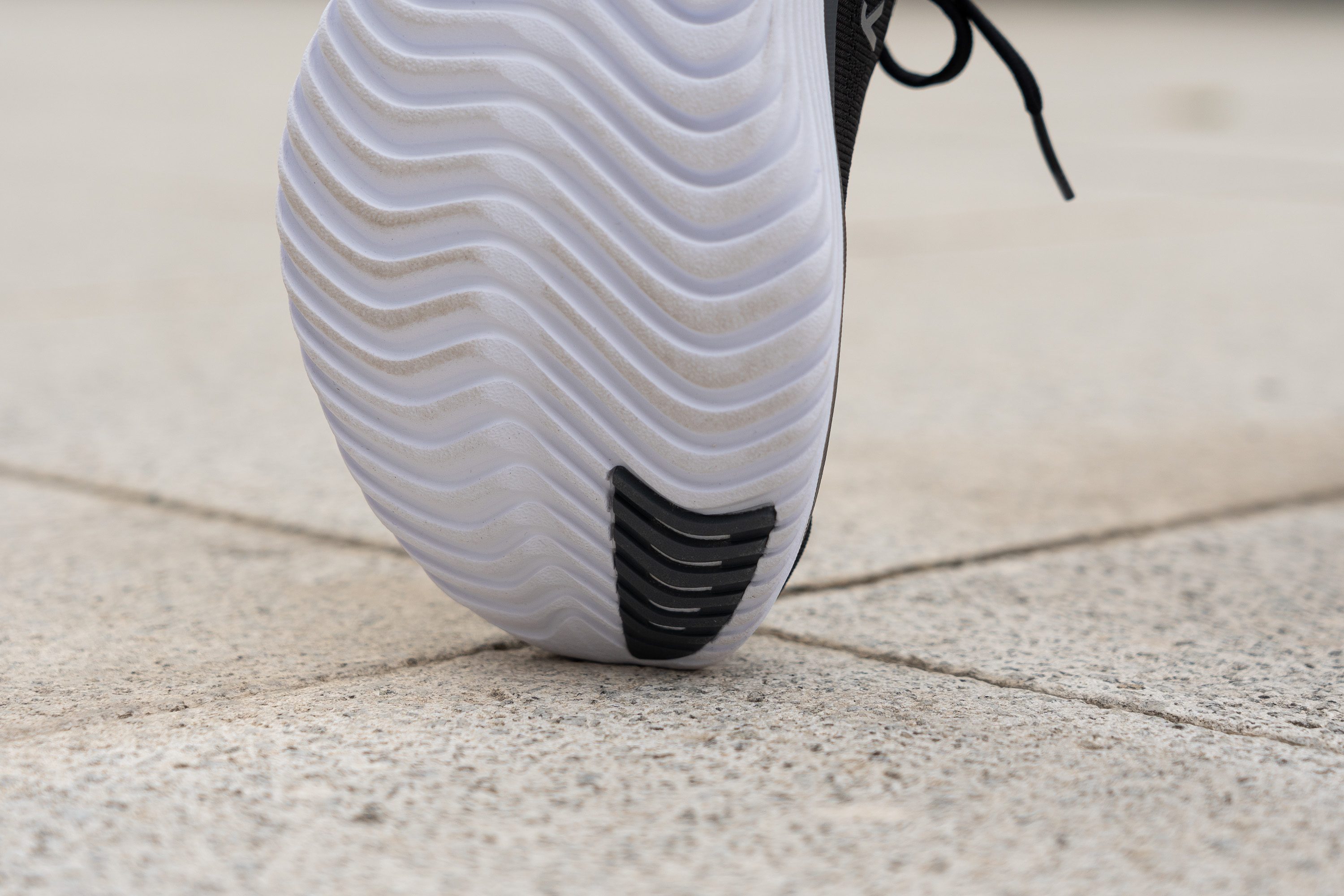
More importantly, at 113.0 mm, the shoe remains exceptionally agile and nimble, a stark contrast to the bulkier running experiences we've encountered recently with maximalist models like the Hoka Skyward X.
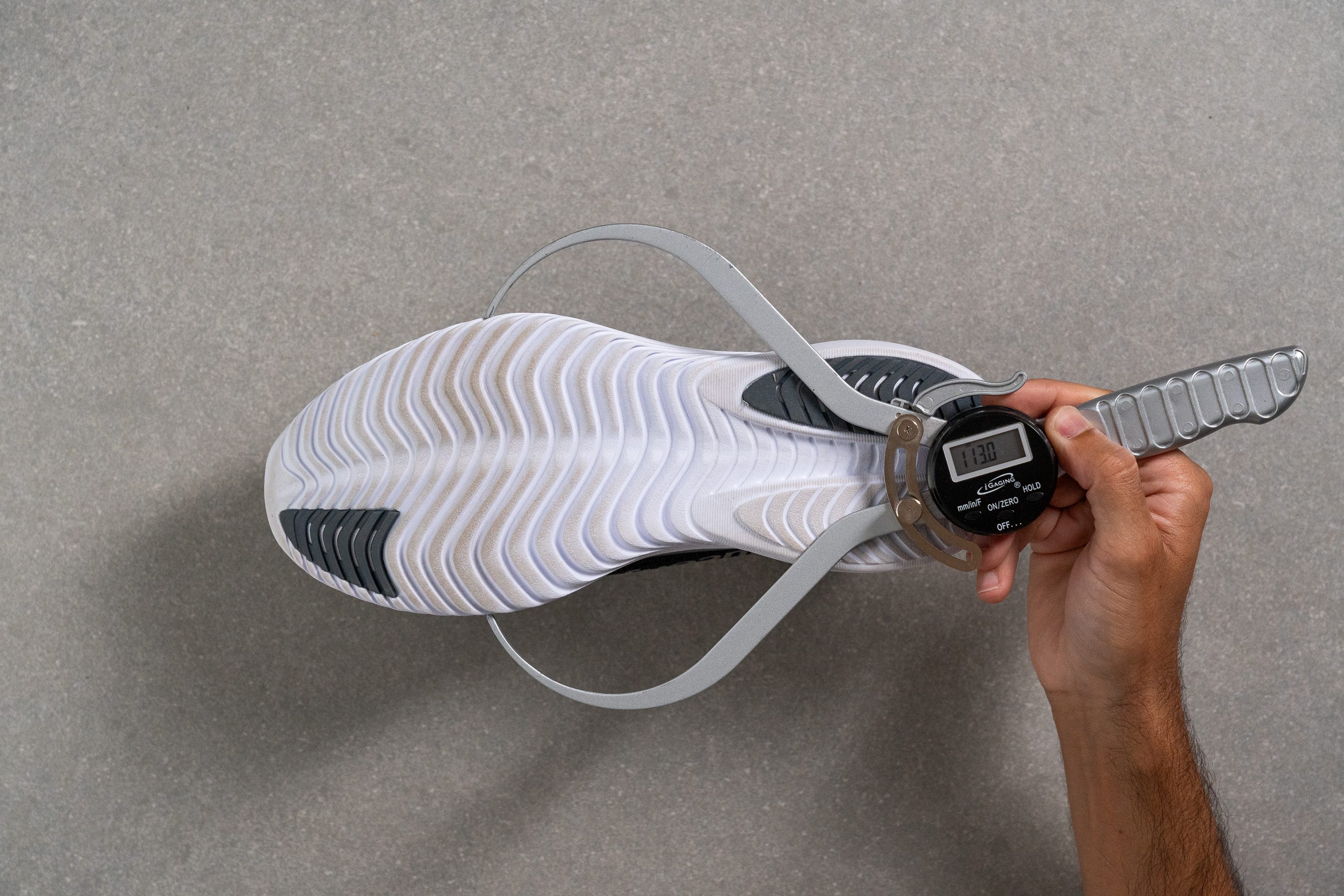
| Kinvara 15 | 113.0 mm |
| Average | 114.4 mm |
Midsole width - heel
The Kinvara 15's midsole narrows to 88.9 mm at the heel, slightly slimmer than the usual, giving this shoe its sleek shape.
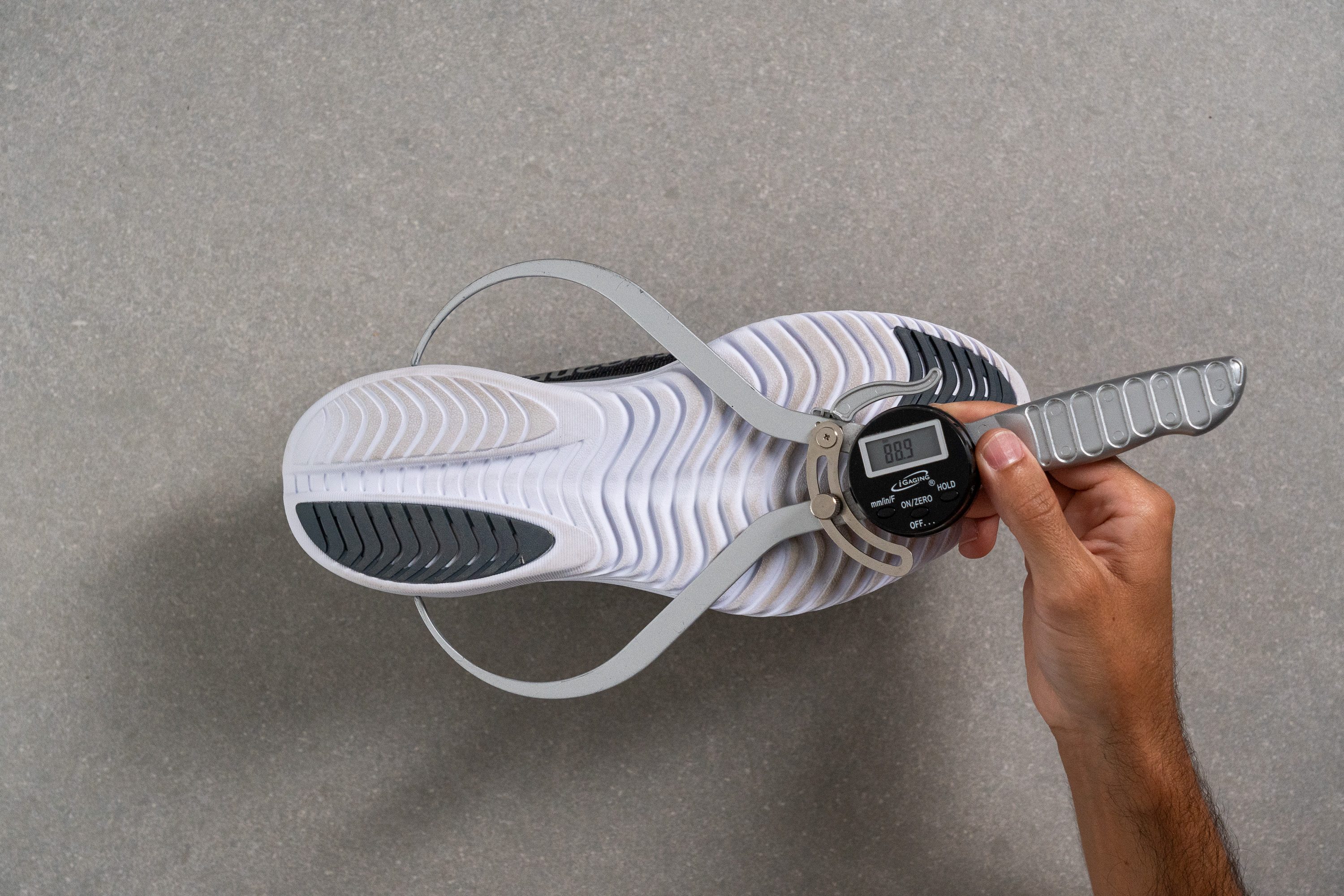
| Kinvara 15 | 88.9 mm |
| Average | 90.7 mm |
Durability
Toebox durability
While the mesh may be airy, the trade-off is its lacklustre durability.
When we tested it with our Dremel, it quickly gave way, resulting in a large hole that garnered a dismal score of 1 out of 5 in our first durability challenge.
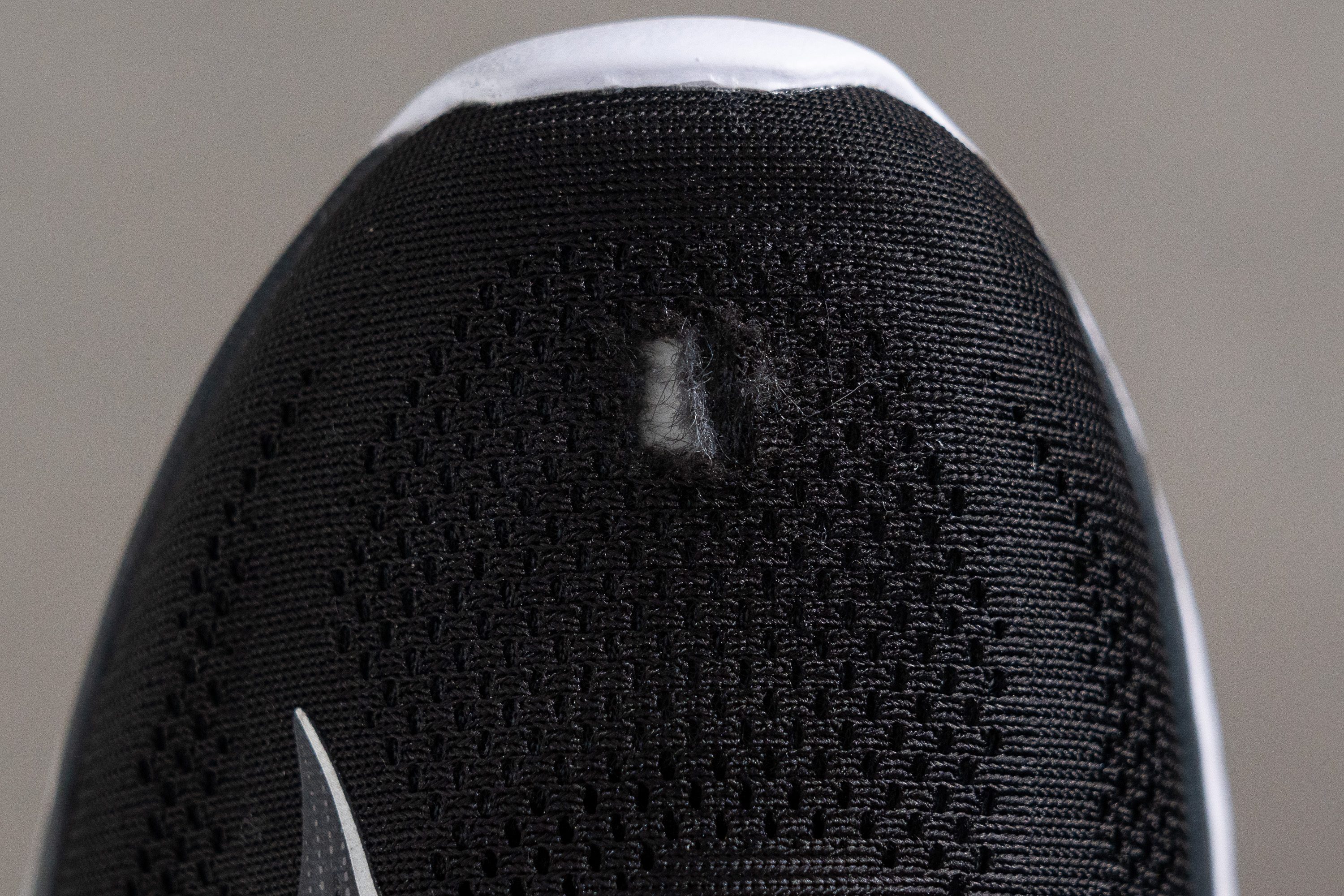
| Kinvara 15 | 1 |
| Average | 2.6 |
Heel padding durability
In our evaluation of the heel collar, we noted that it's constructed from a tougher fabric designed to enhance durability and reduce the likelihood of heel slippage too.
To further assess its durability, we conducted a second Dremel test on this section. Impressively, the heel lining sustained minimal damage, leading us to award it a perfect score of 5 out of 5 for durability.
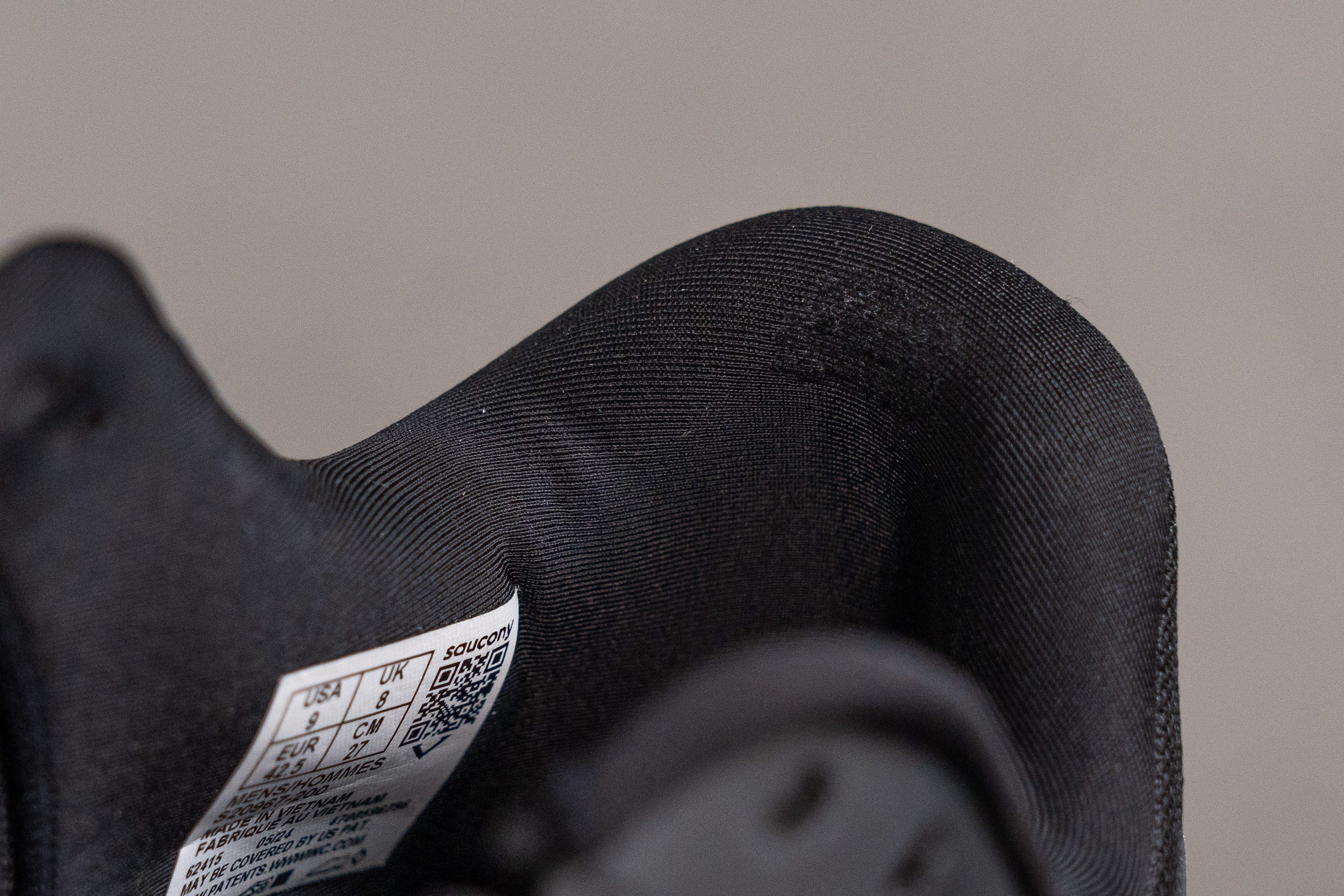
| Kinvara 15 | 5 |
| Average | 3.4 |
Outsole hardness
The Kinvara 15 retains the same rubber as its predecessor, the Kinvara 14, and our tests with the Shore C durometer confirmed this with a reading of 79.1 HC.

This is an average hardness reading for an outsole, but Saucony's commitment to ultimate lightness means continuing with minimal rubber coverage, raising some durability concerns.
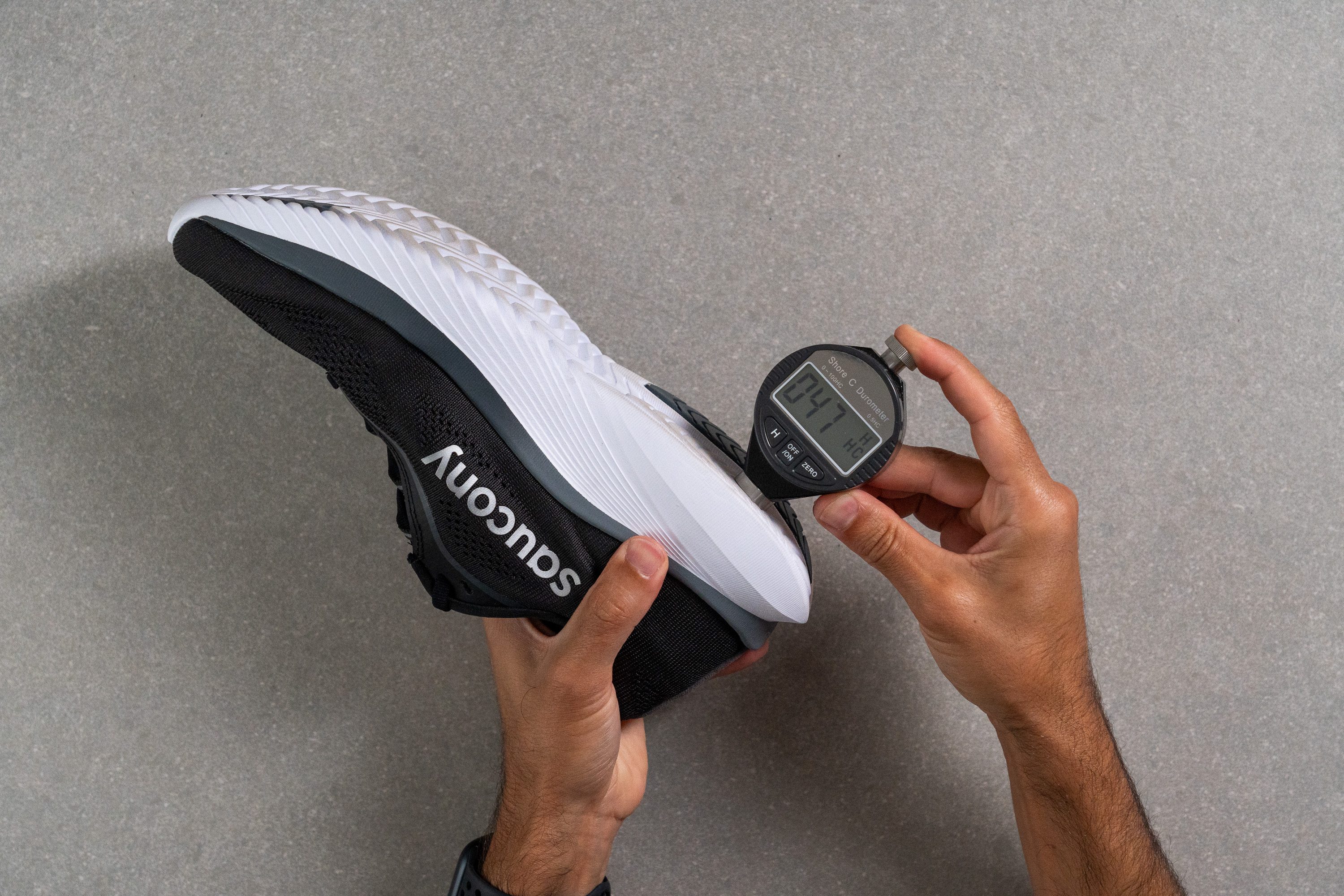
Since the exposed midsole prevails so much in this shoe, we examined the rubberized EVA too. We recorded a hardness of 47.0 HC, which aligns with similar outsoles found in shoes such as the ASICS Cumulus 26. Hence, expect medium-to-low durability overall.
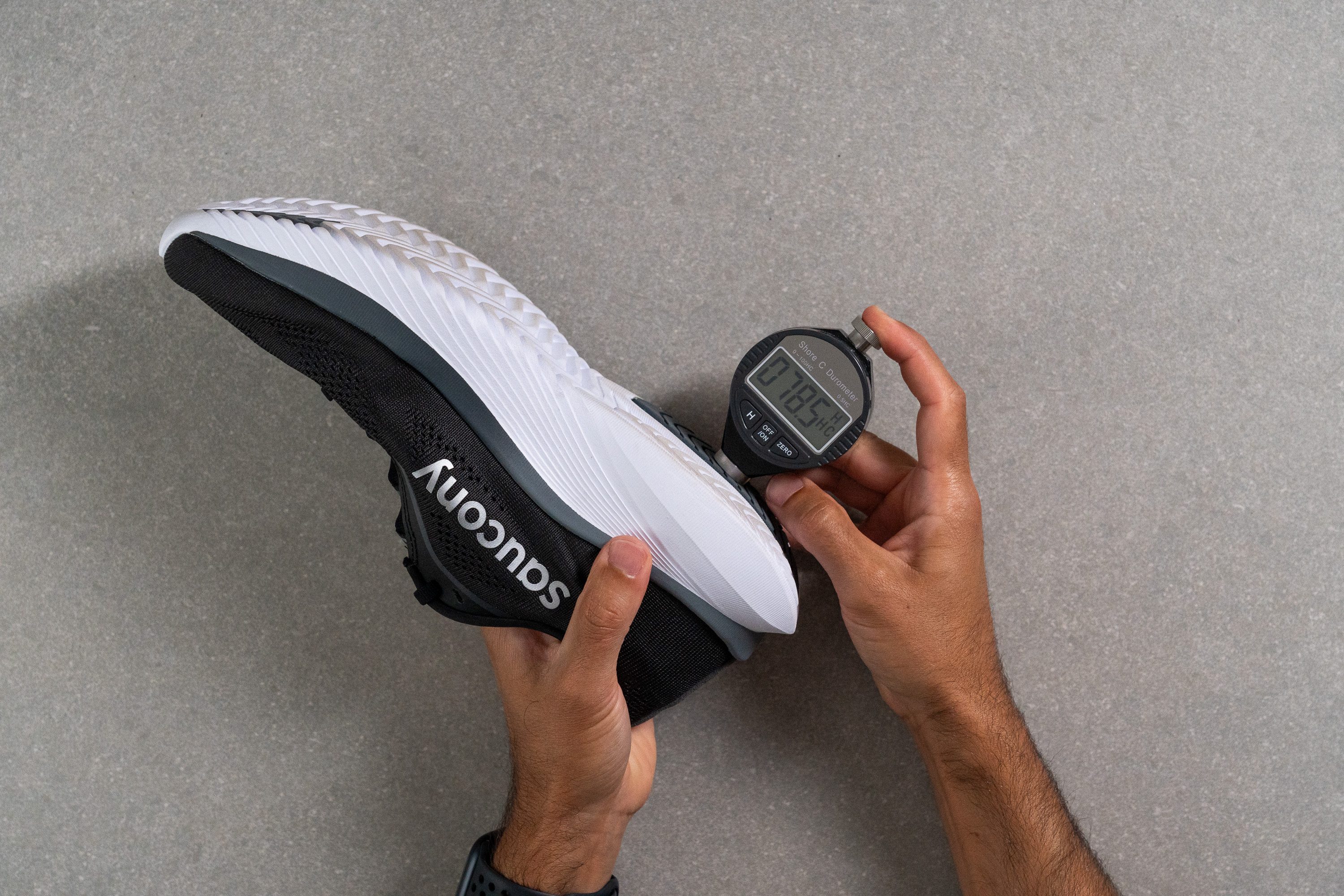
| Kinvara 15 | 79.1 HC |
| Average | 79.2 HC |
Outsole durability
On the positive side, the small rubber pad in the heel showed good resilience in our latest Dremel test, with only a 0.9 mm indentation found.
Given the design of the outsole, we recommend this shoe for neutral runners. Those who tend to land on the sides of their heel may experience rapid wear on the outsole, particularly those who pronate.
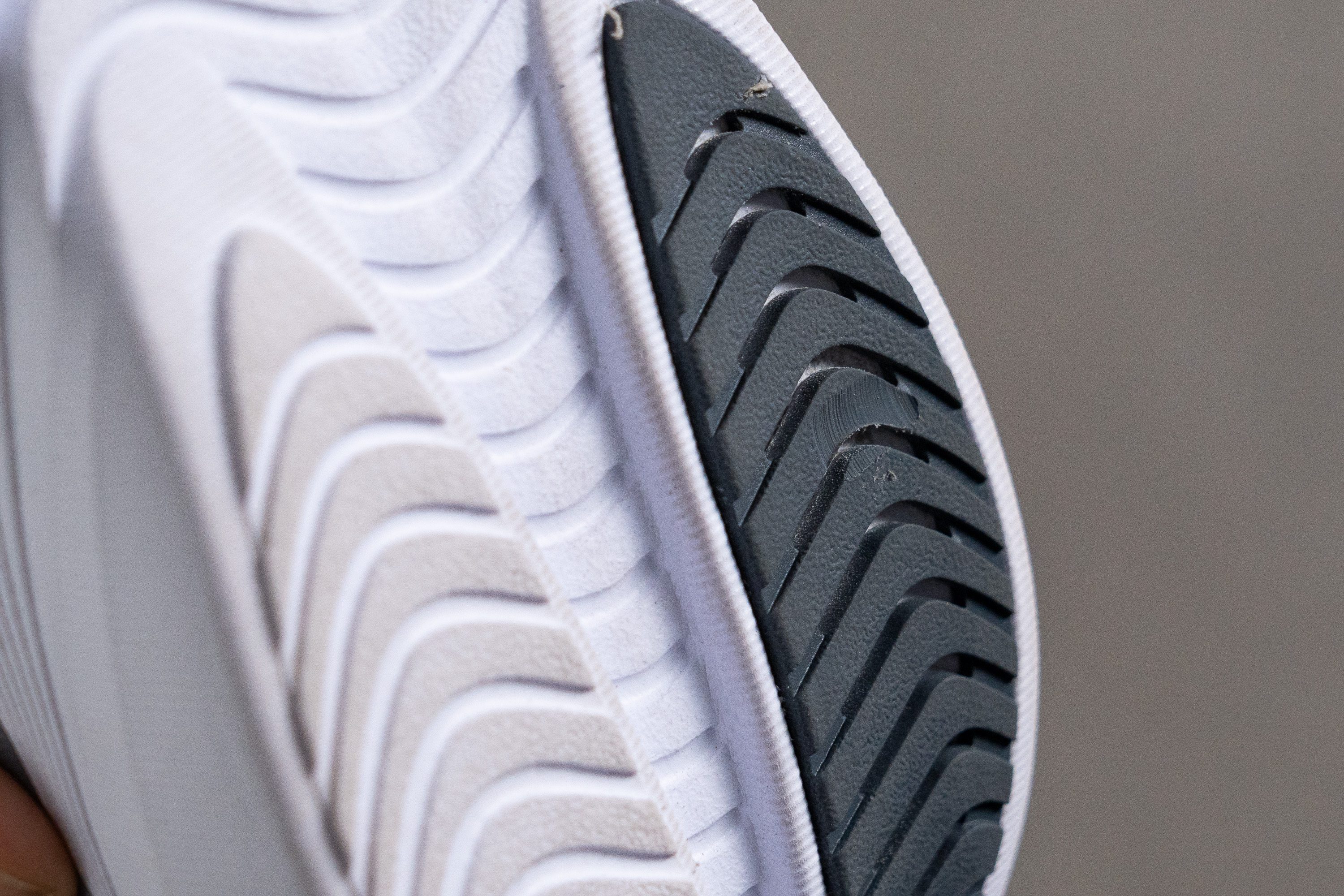
| Kinvara 15 | 0.9 mm |
| Average | 1.1 mm |
Outsole thickness
Saucony included an outsole thickness of 3.0 mm, which was a surprise. Given their minimalist approach to the outsole design and the 2.4-mm measurement that we took in its predecessor, we had anticipated an even thinner layer!
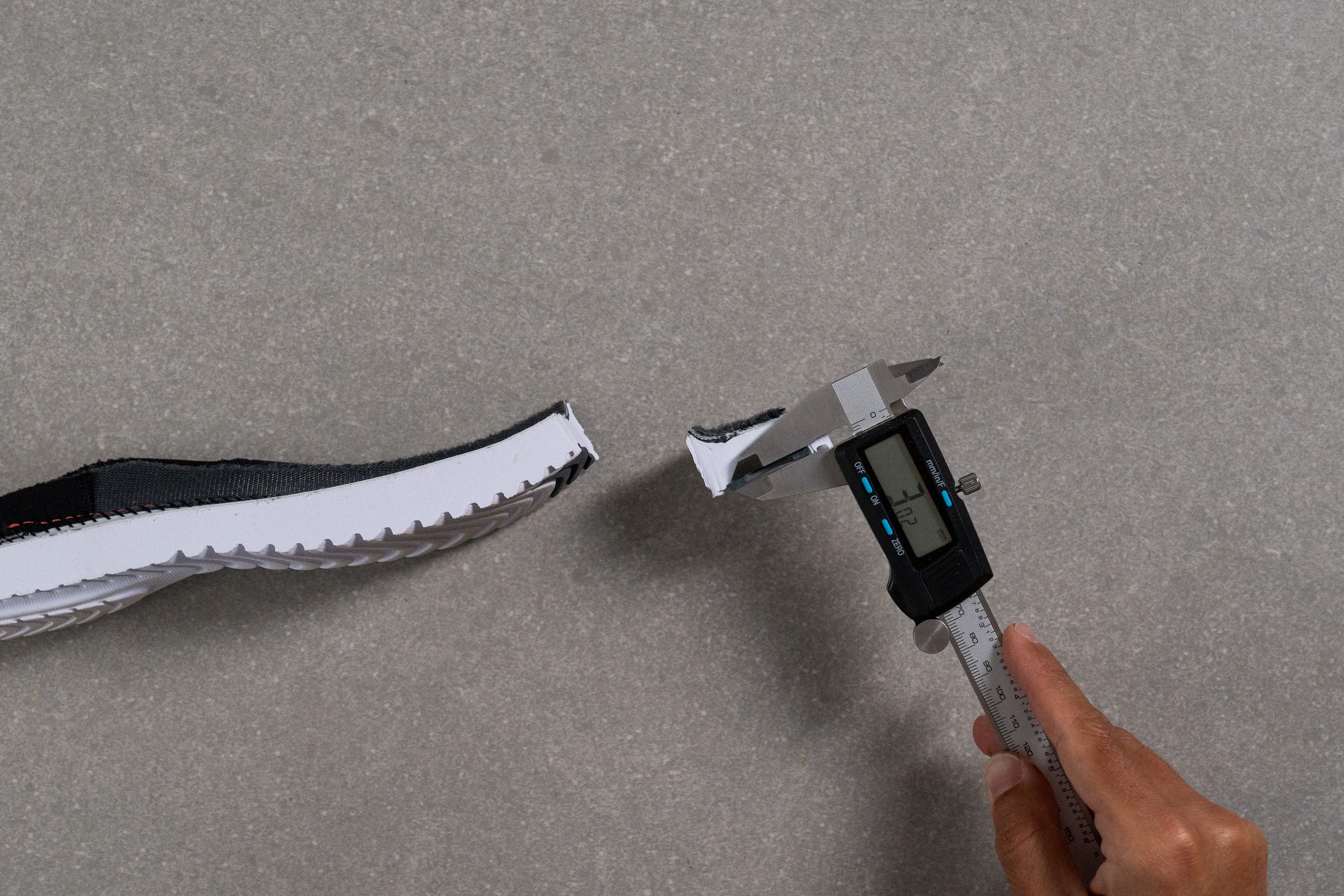
| Kinvara 15 | 3.0 mm |
| Average | 3.2 mm |
Misc
Insole thickness
Our measurement indicated an insole thickness of 4.2 mm, aligning with the average reading typically found in most road running shoes.
However, there's a catch—the footbed isn't made from the usual cheap EVA. Instead, it's crafted from PWRRUN+ foam, which offers even greater responsiveness than the shoe's midsole.

| Kinvara 15 | 4.2 mm |
| Average | 4.5 mm |
Removable insole
The Kinvara 15 comes with a standard-shaped insole made of PWRRUN+ foam, which adds significant bounce. We recommend keeping this insole in place to preserve its fantastic performance unless a replacement is absolutely necessary.
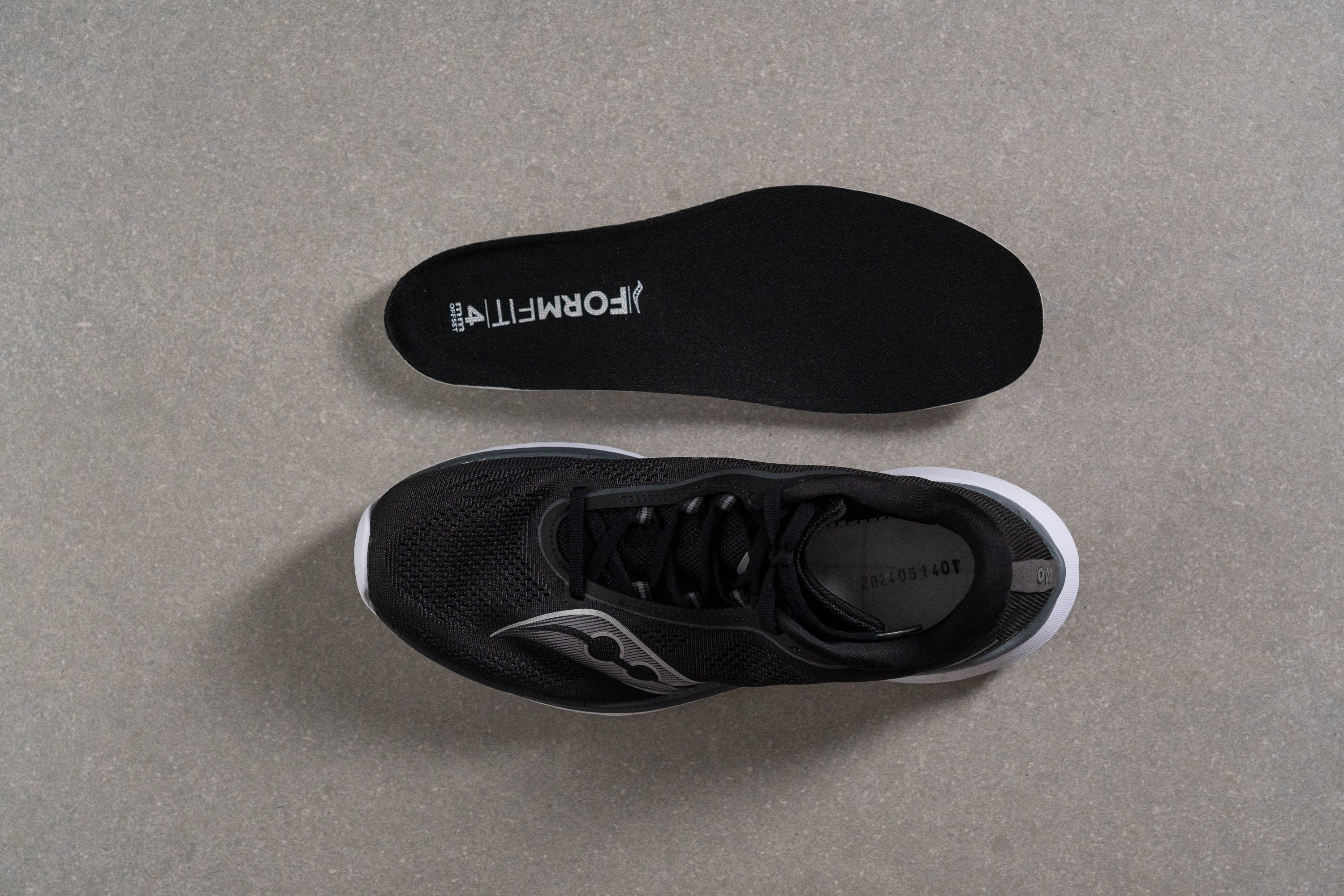
| Kinvara 15 | Yes |
Midsole softness in cold (%)
While EVA foams typically struggle in cold temperatures, PWRRUN—a blend of EVA and a bit of TPU as we said before—impressively excelled in our freezer test, becoming only 18.9% firmer.
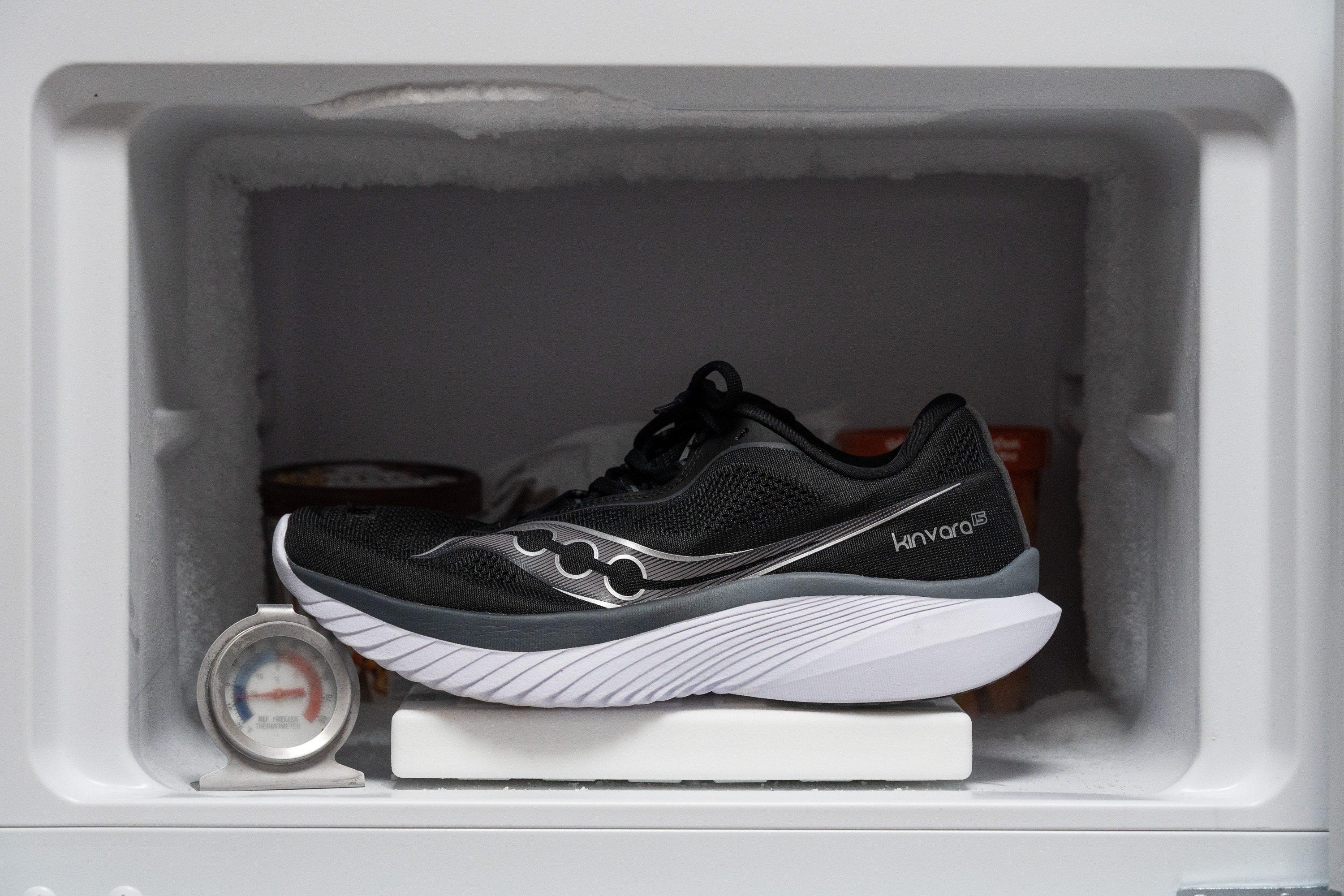
| Kinvara 15 | 19% |
| Average | 24% |
Reflective elements
We were pleasantly surprised to find reflective elements included for such an affordable price. Although they're not large by any means, they provide enough visibility to enhance safety at night when cars approach from behind.
| Kinvara 15 | Yes |
Tongue padding
While the midsole and outsole closely resemble those of the Kinvara 14, the 15th edition introduces a plush tongue that's 8.0 mm thick—more than twice the thickness of its predecessor.
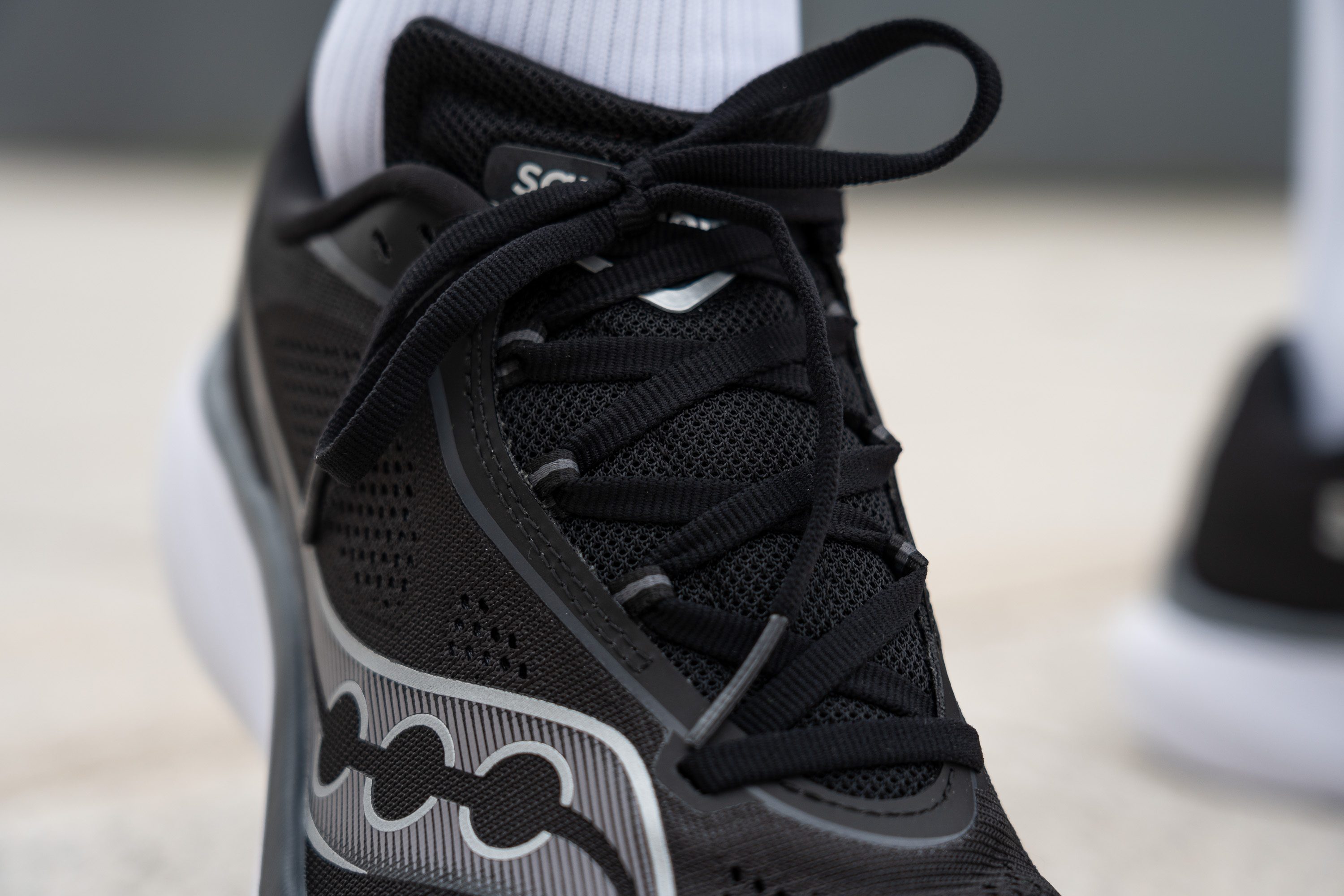
This change has its pros and cons. On one hand, the thicker tongue enhances the fit, making it feel more luxurious and comfortable. However, given that the Kinvara is known for its lightweight design, the added bulk of the tongue seems somewhat counterproductive, particularly since this isn't designed as a long-distance shoe but the opposite.

| Kinvara 15 | 8.0 mm |
| Average | 5.8 mm |
Tongue: gusset type
We already believed that the Kinvara 15 provides outstanding value given its low MSRP, but discovering its semi-gusseted tongue solidified our view. This feature truly makes it an A+ shoe in terms of value for the price!
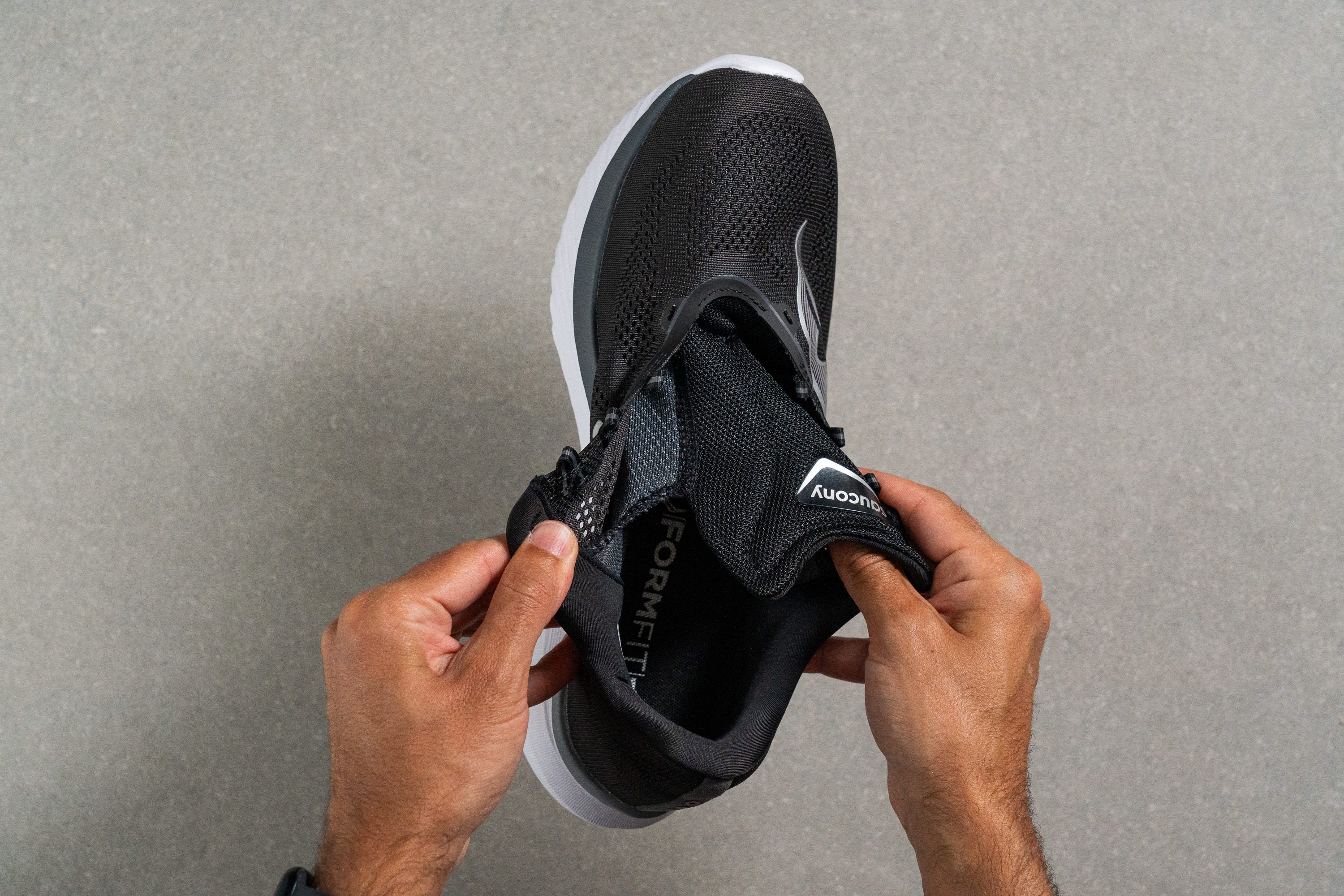
| Kinvara 15 | Both sides (semi) |
Price
This running shoe also excels in affordability. Priced just over £100, it ranks as one of our top choices for anyone in search of a low-stack, flexible running shoe.
| Kinvara 15 | $120 |
Heel tab
We noted that some of the design elements have been carried over from its predecessor. As with the previous model, this version also lacks a heel tab, maintaining a consistent design.
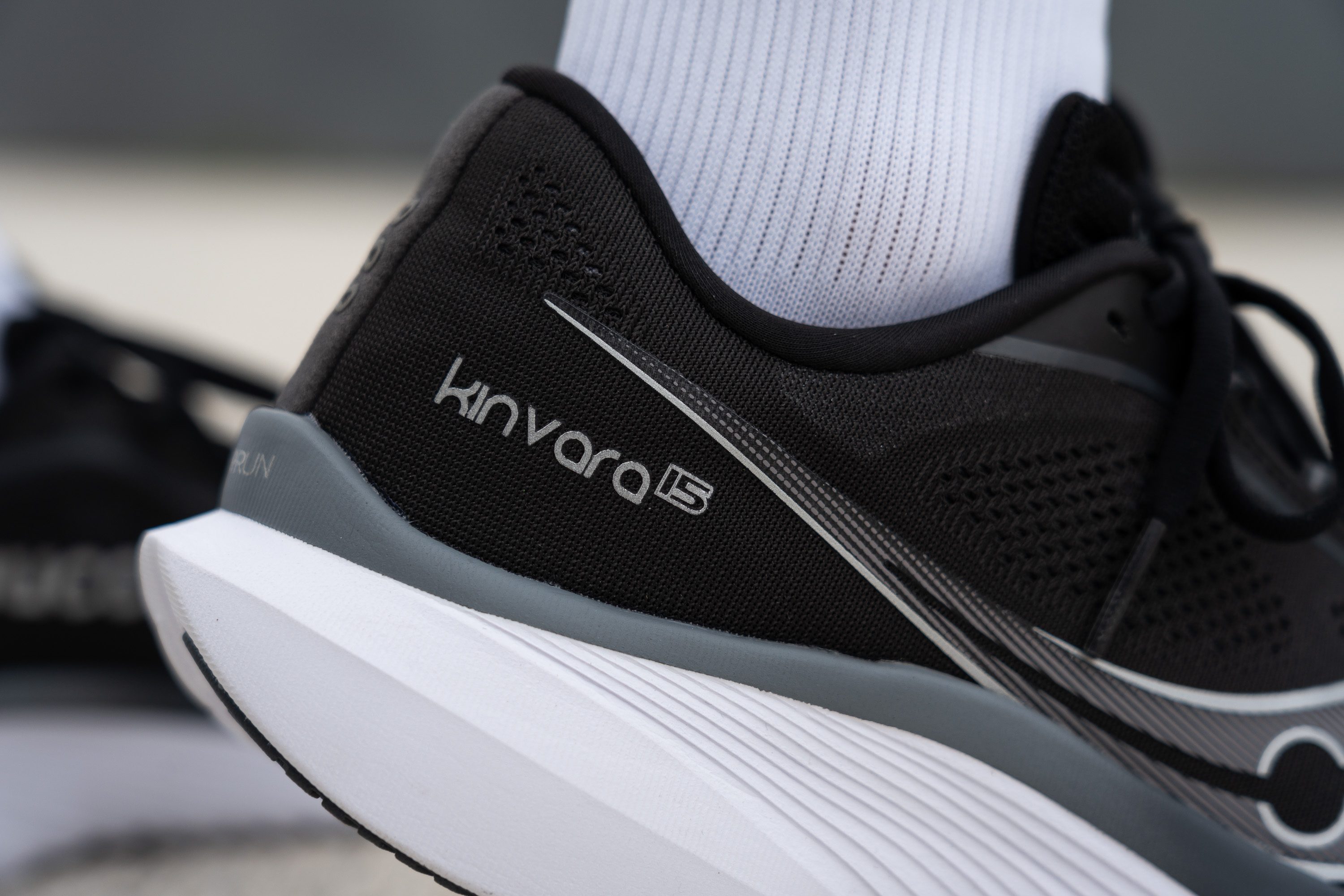
| Kinvara 15 | None |

